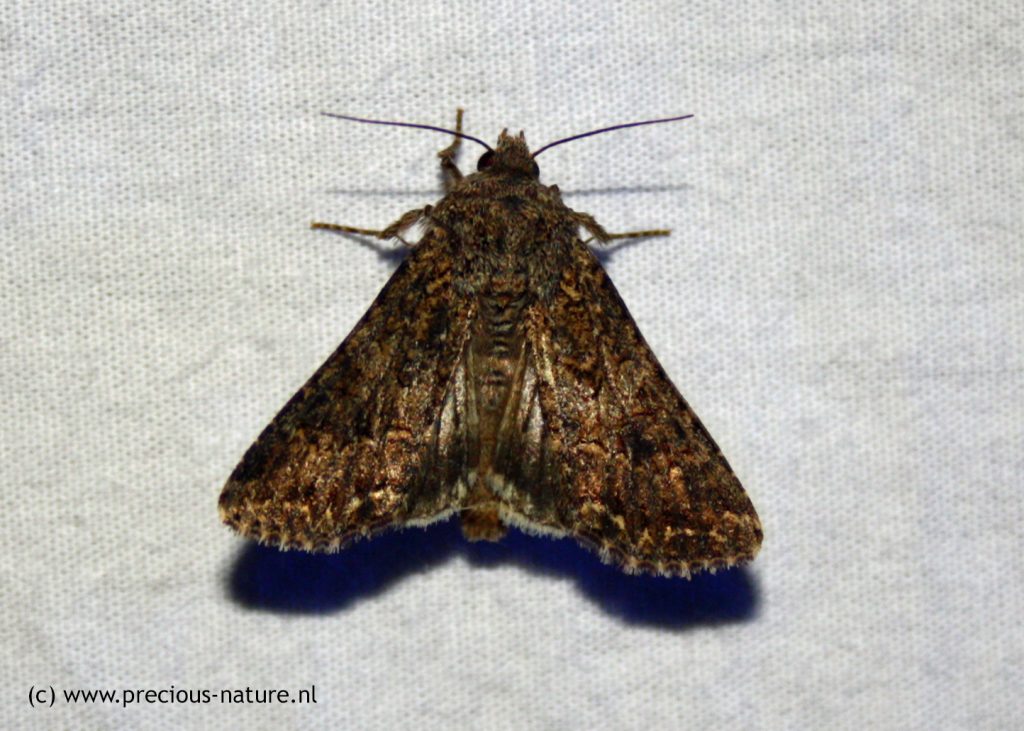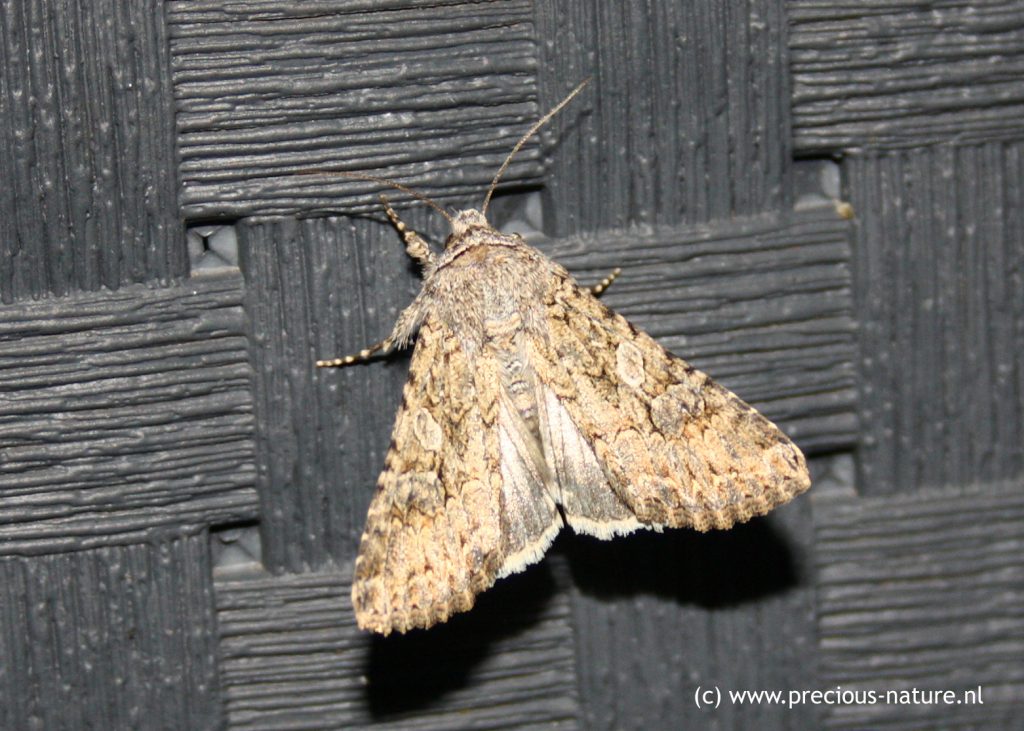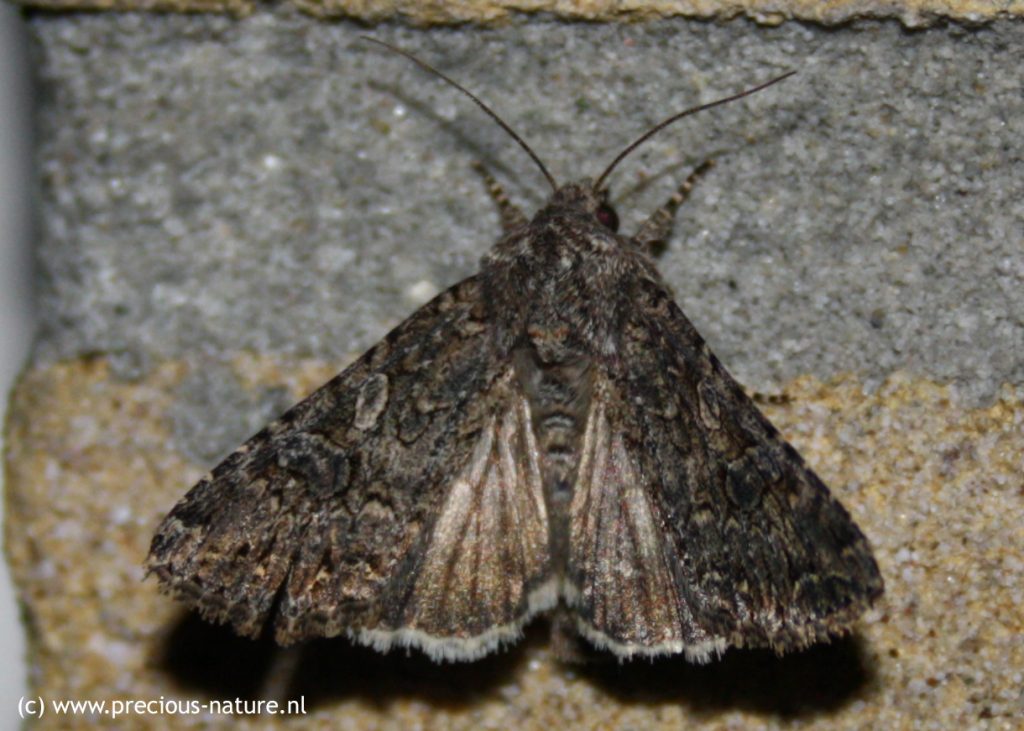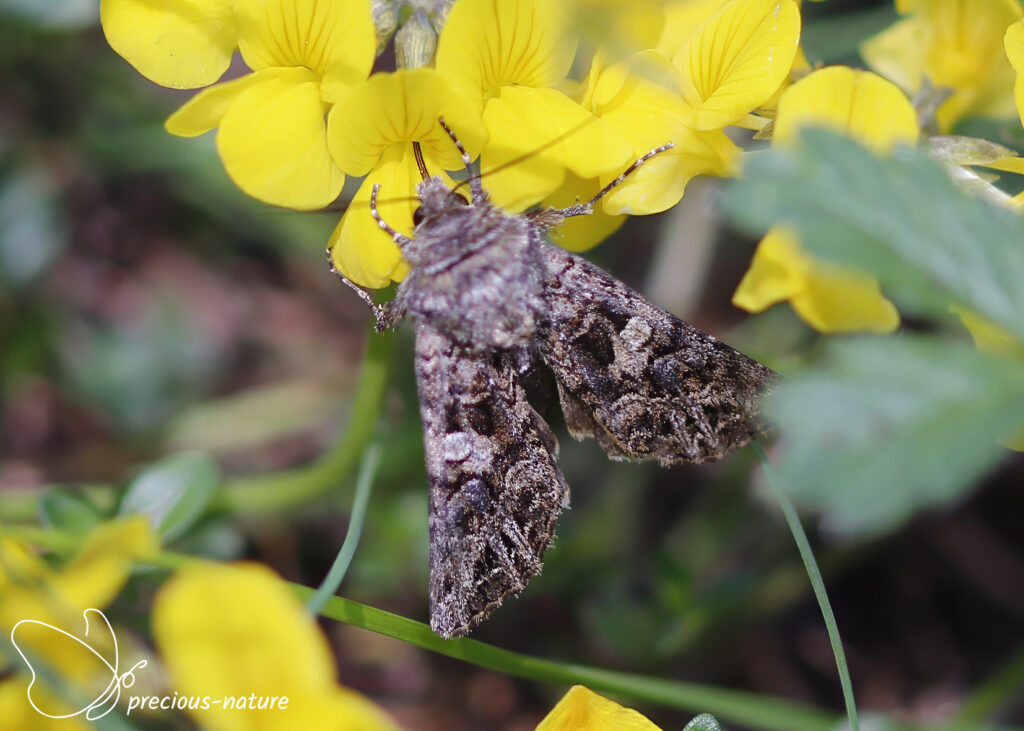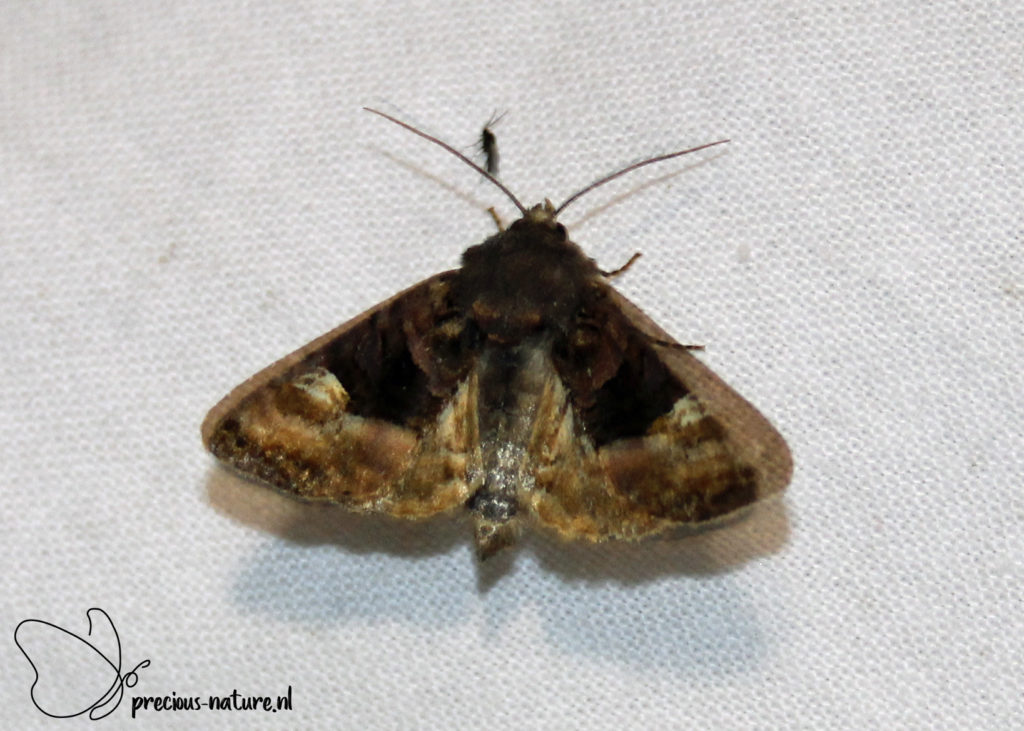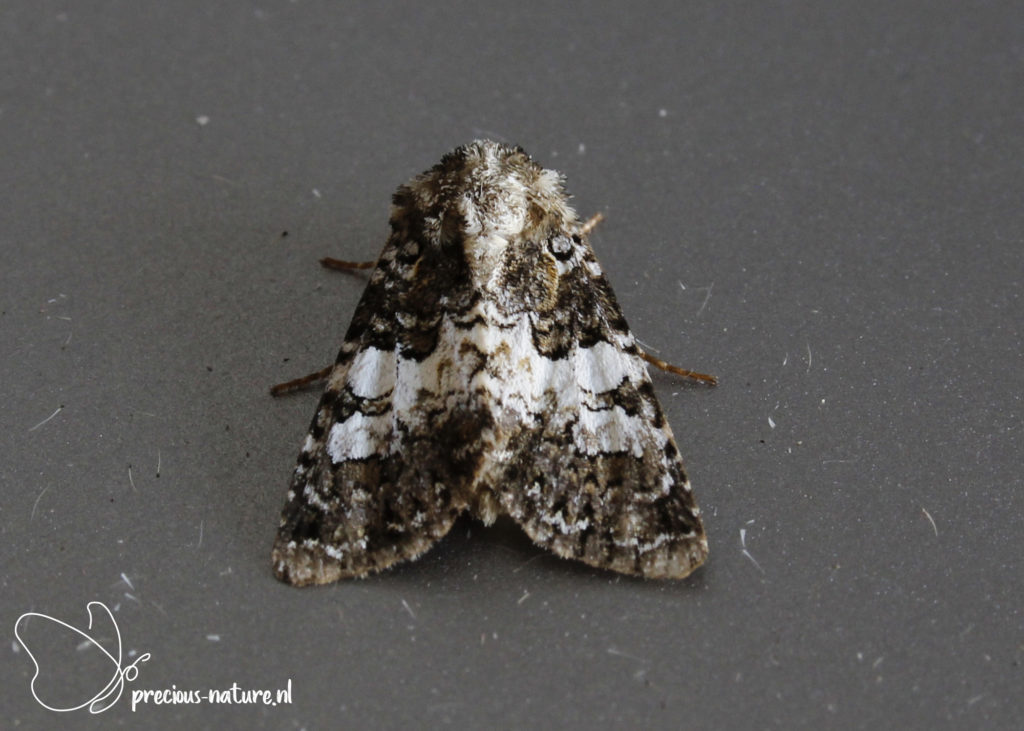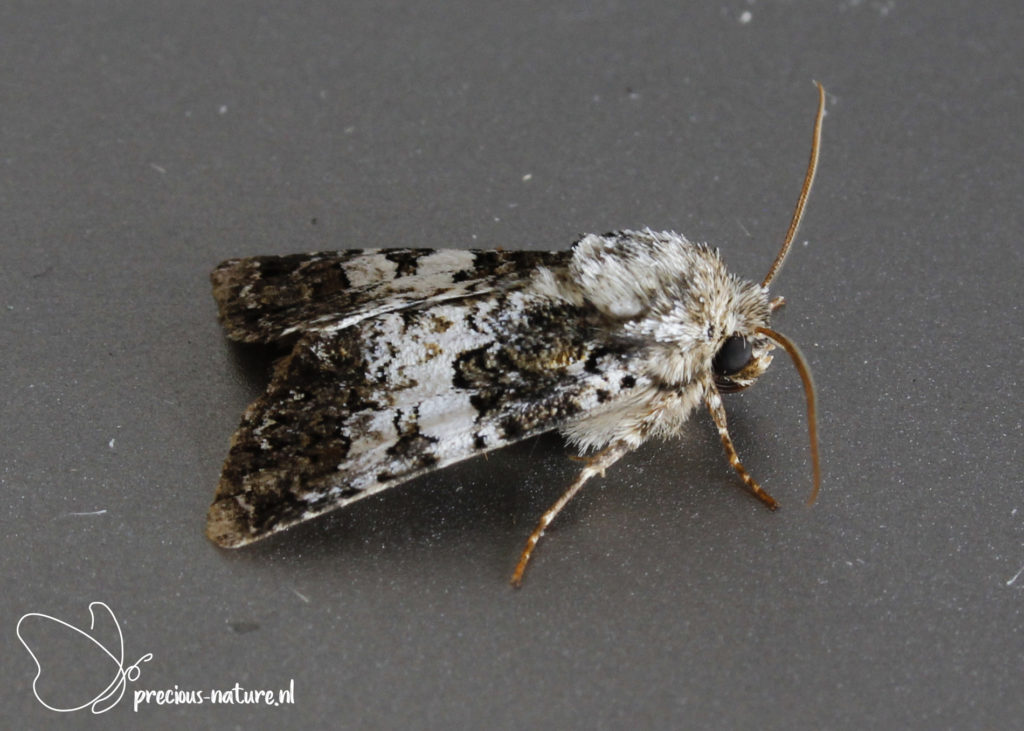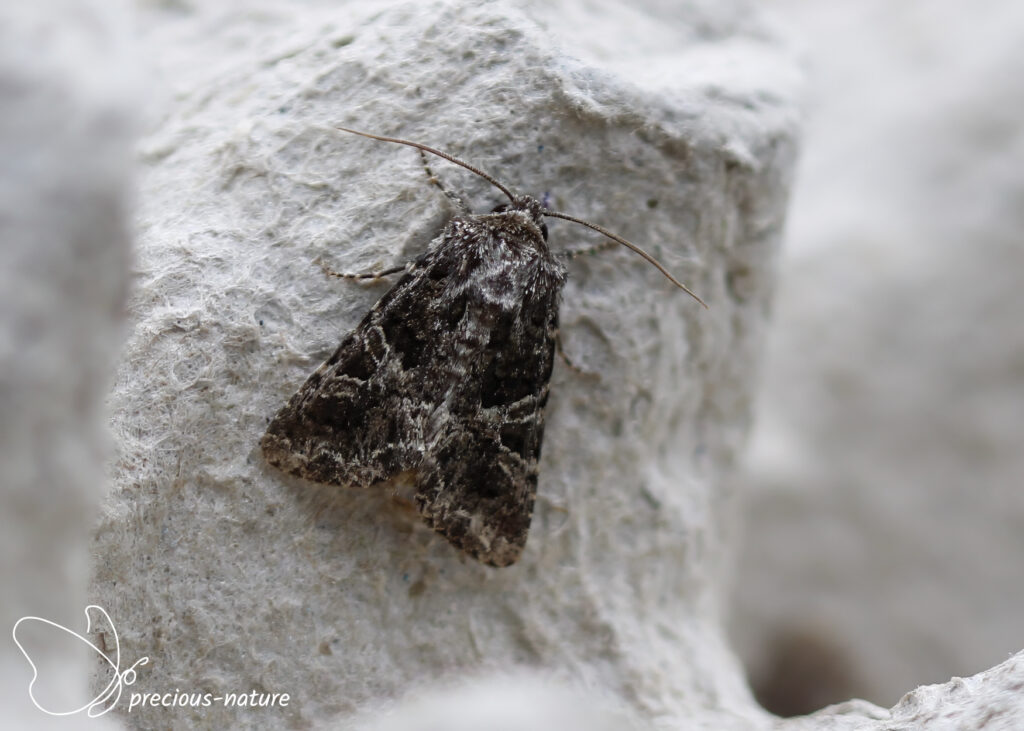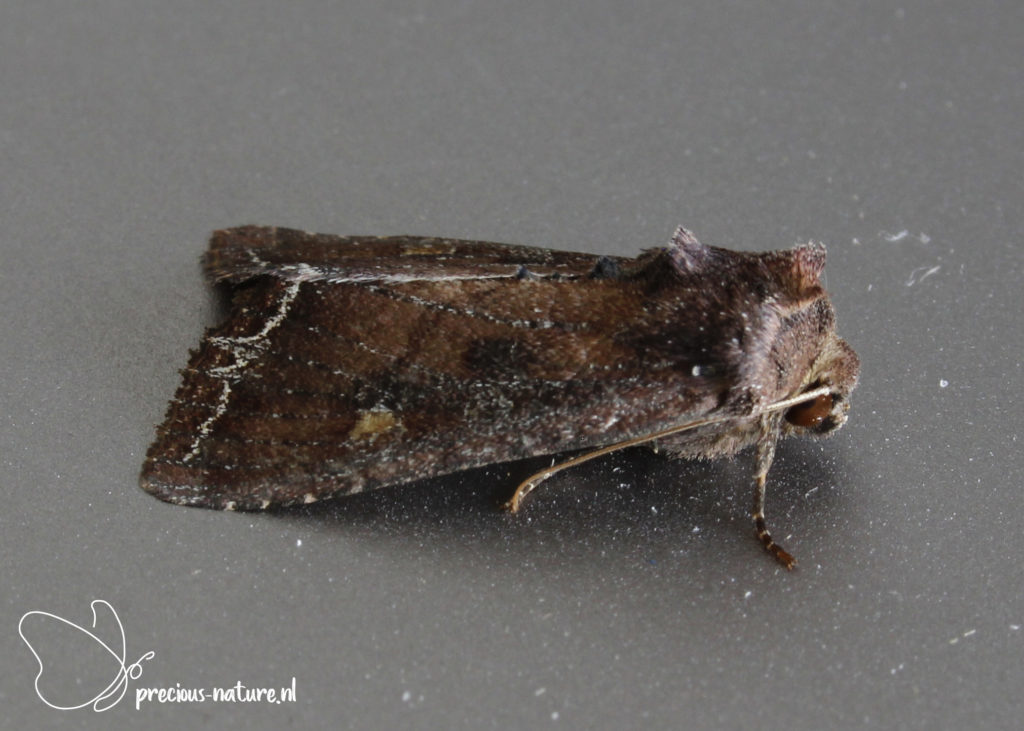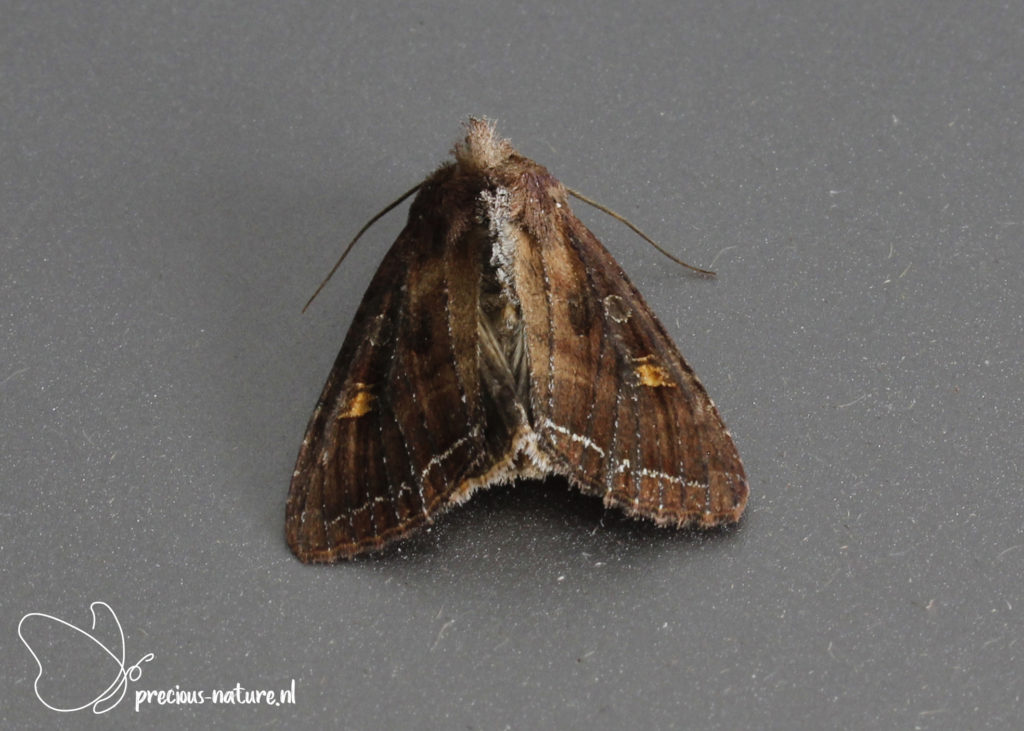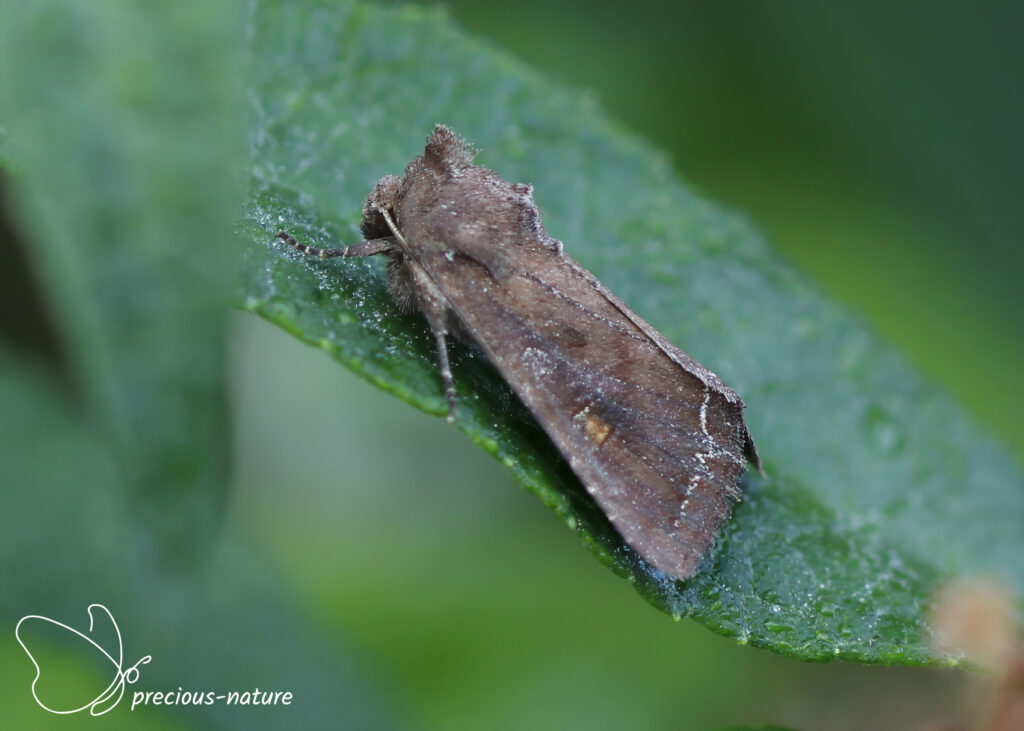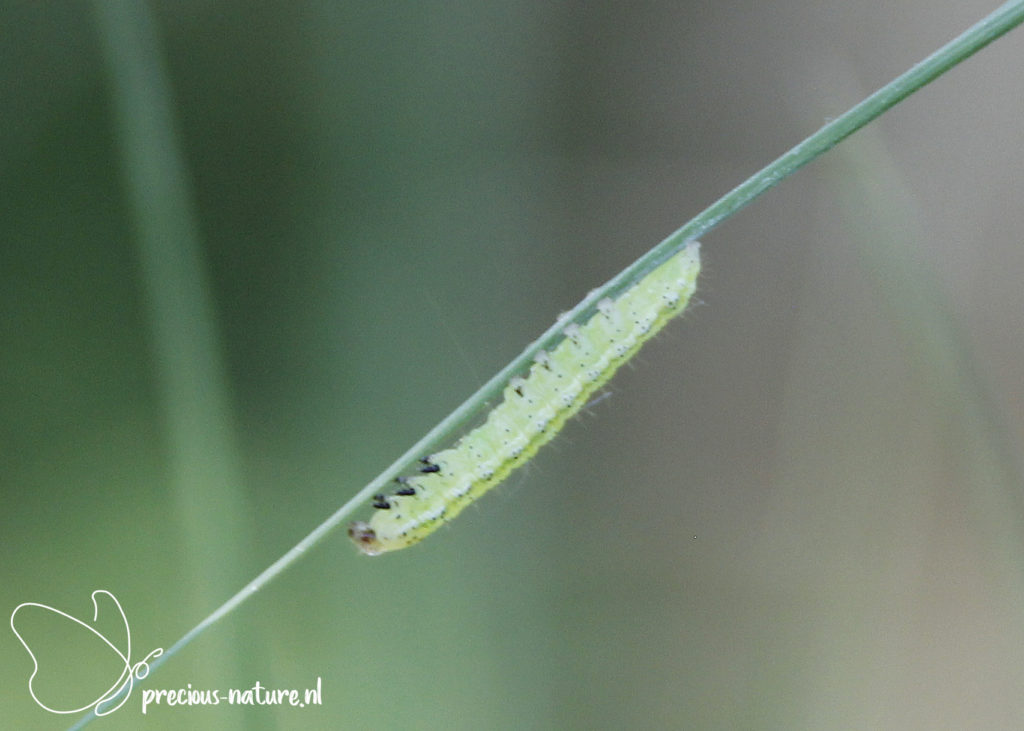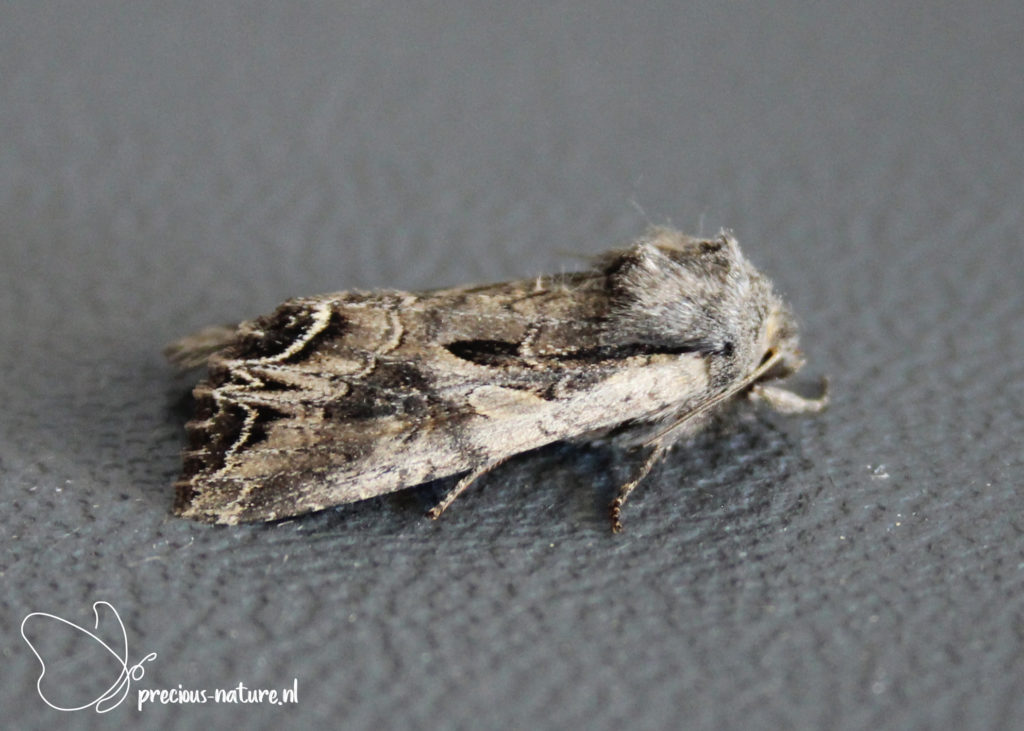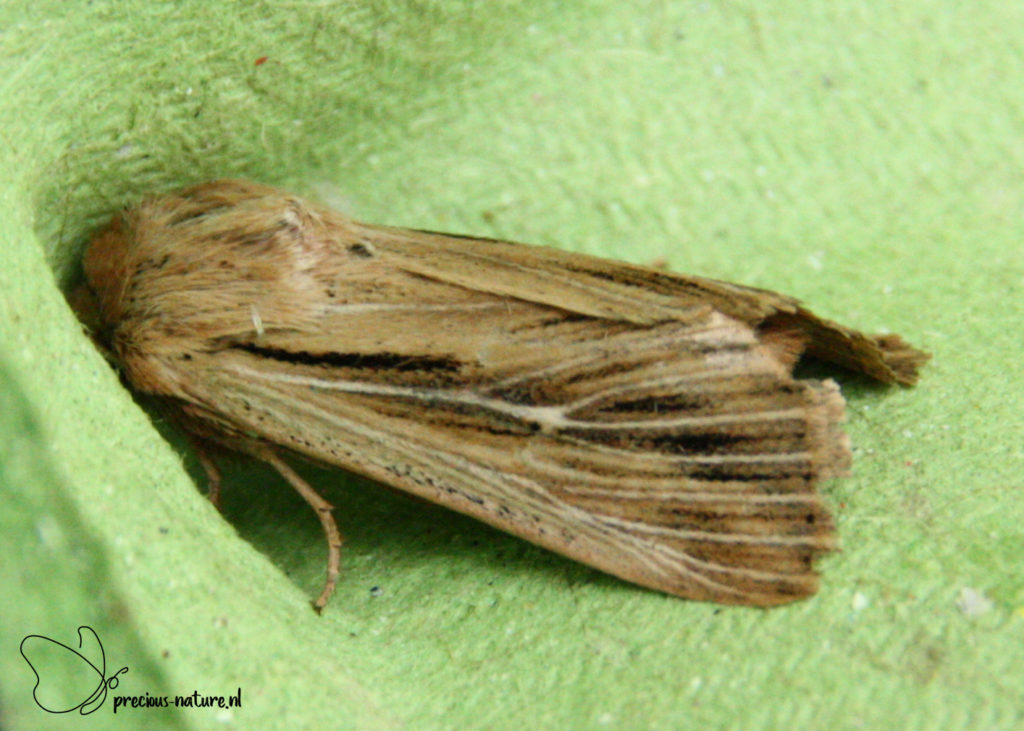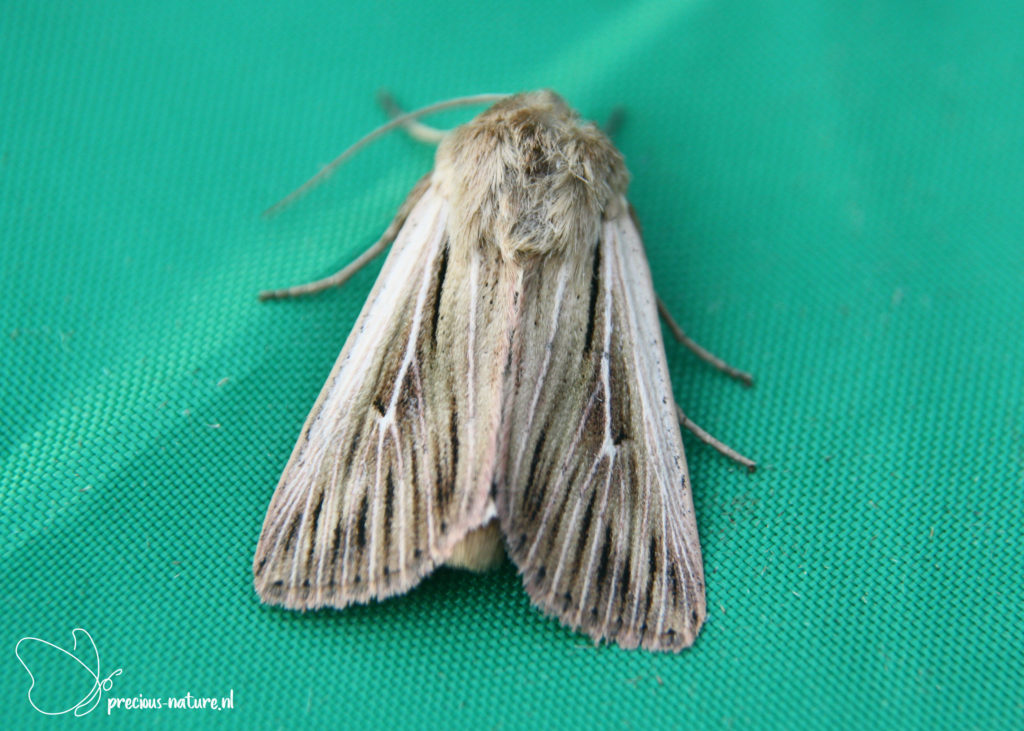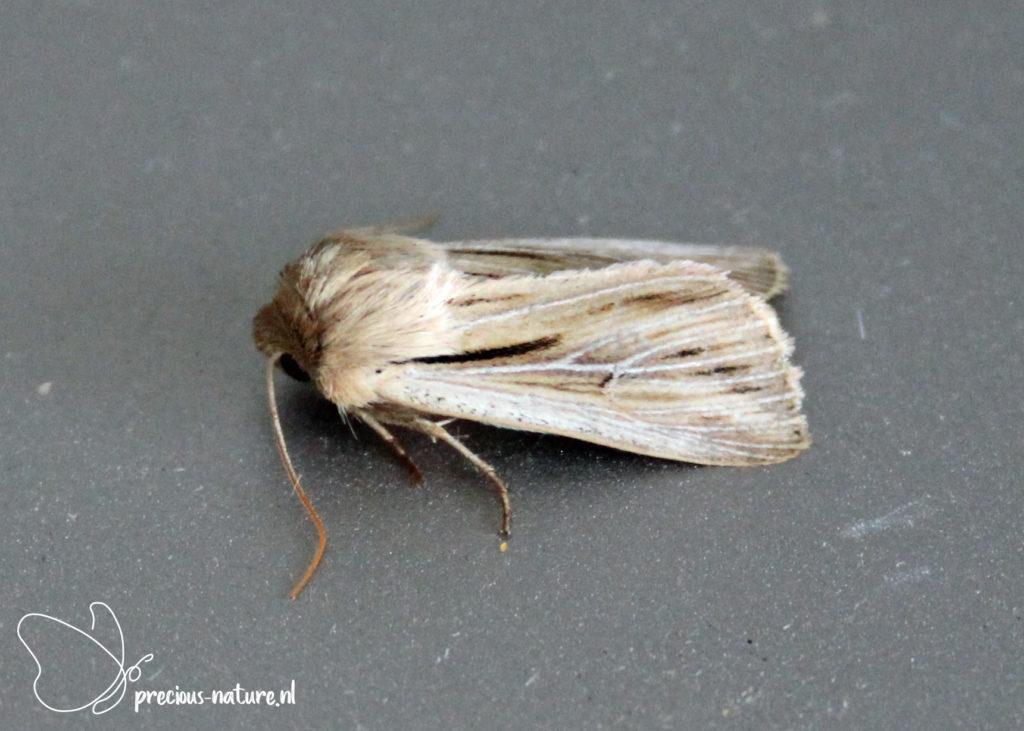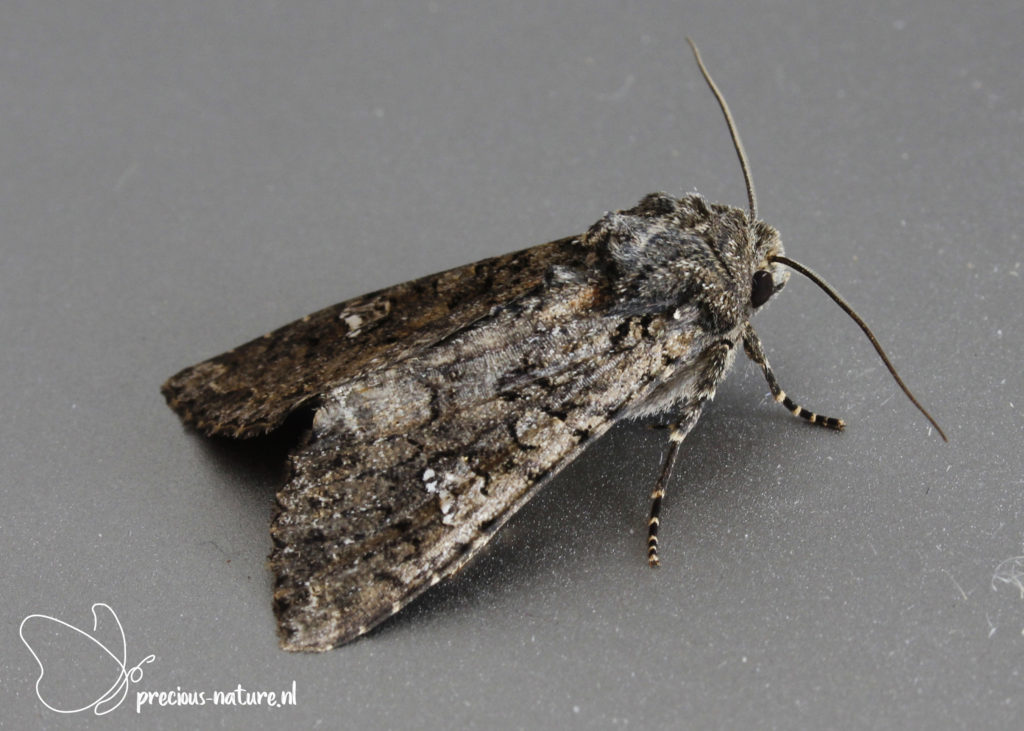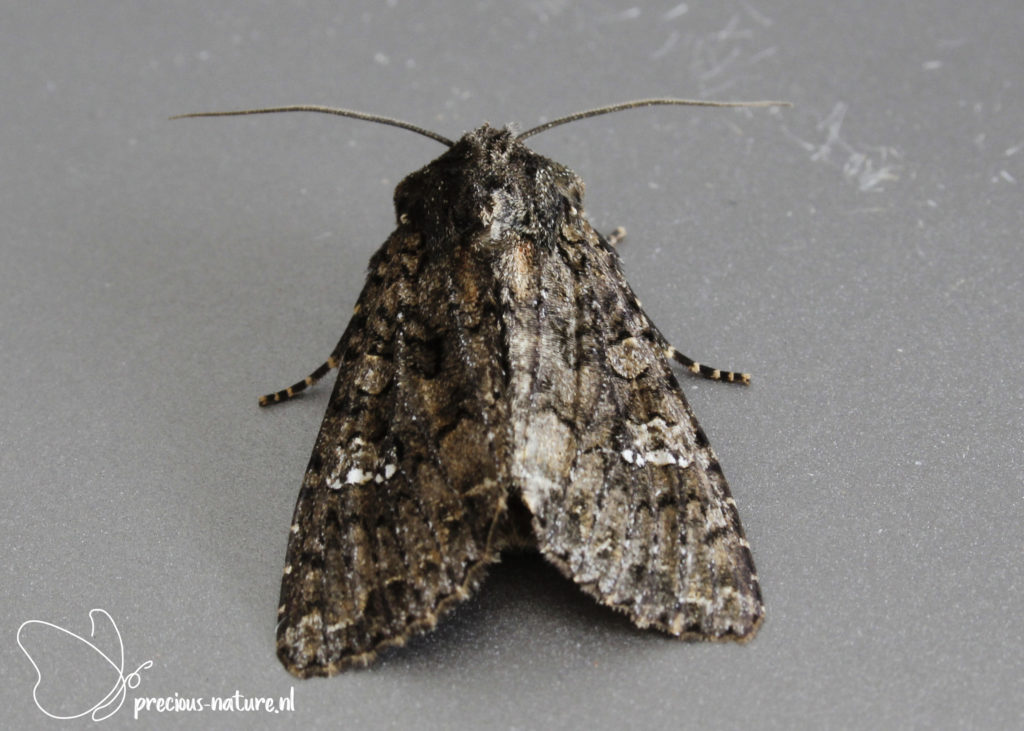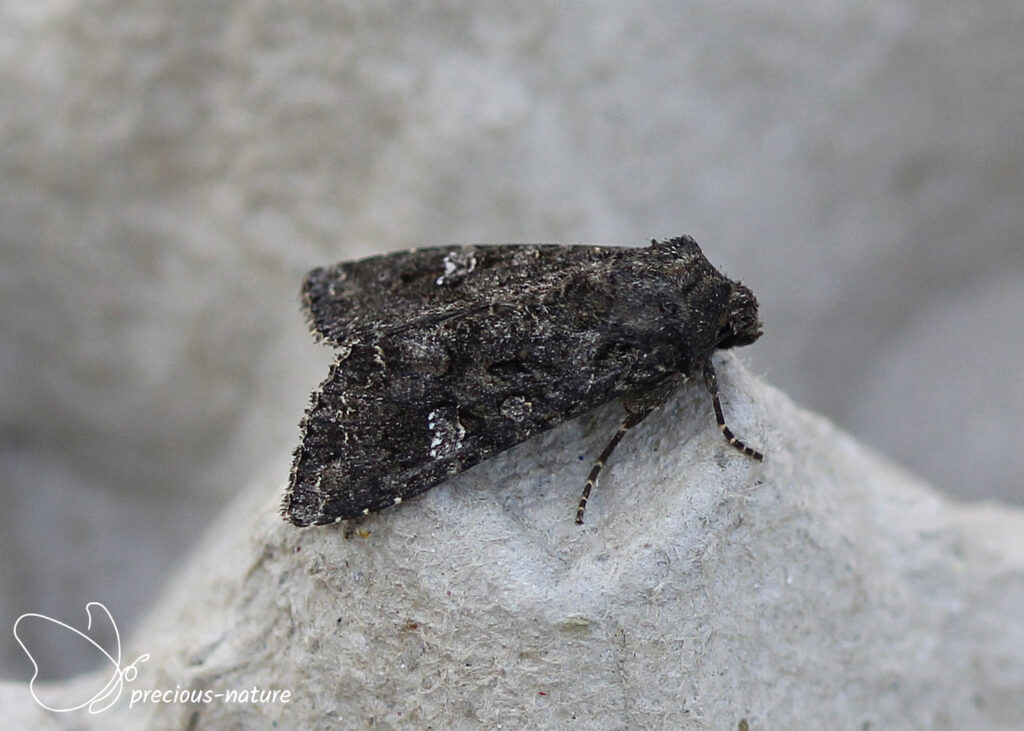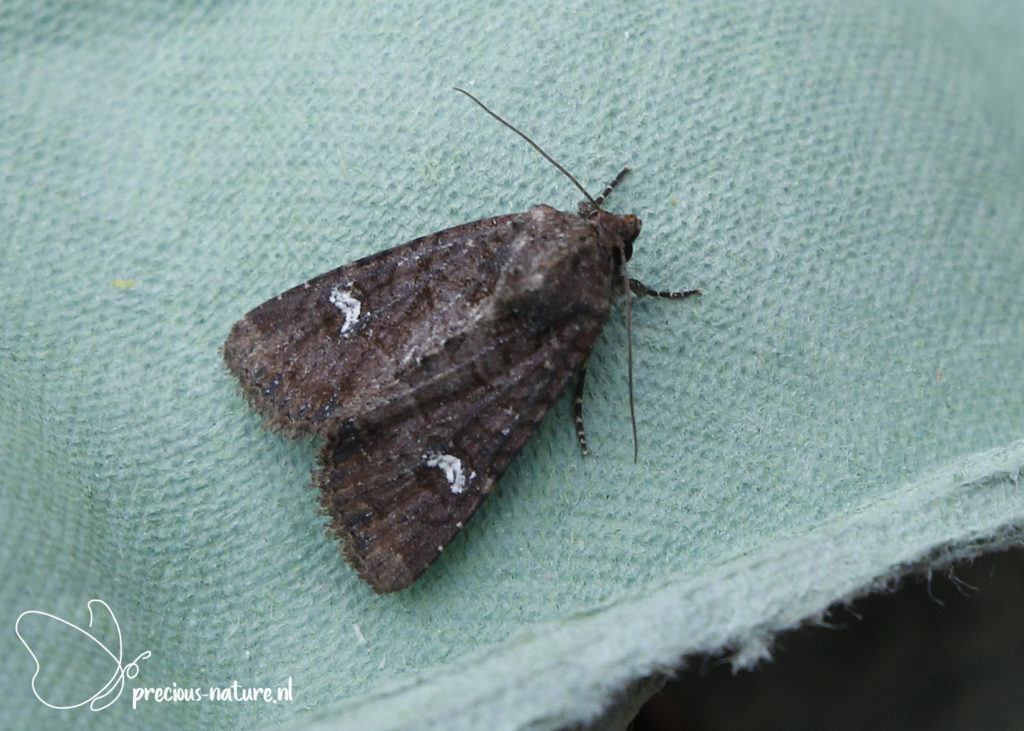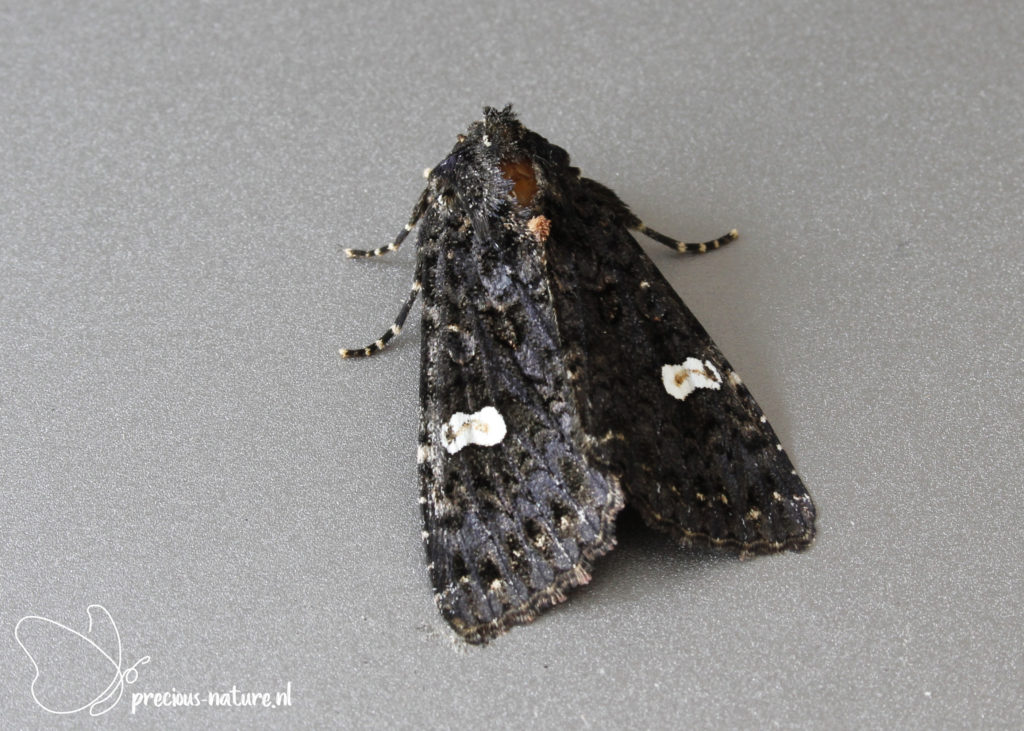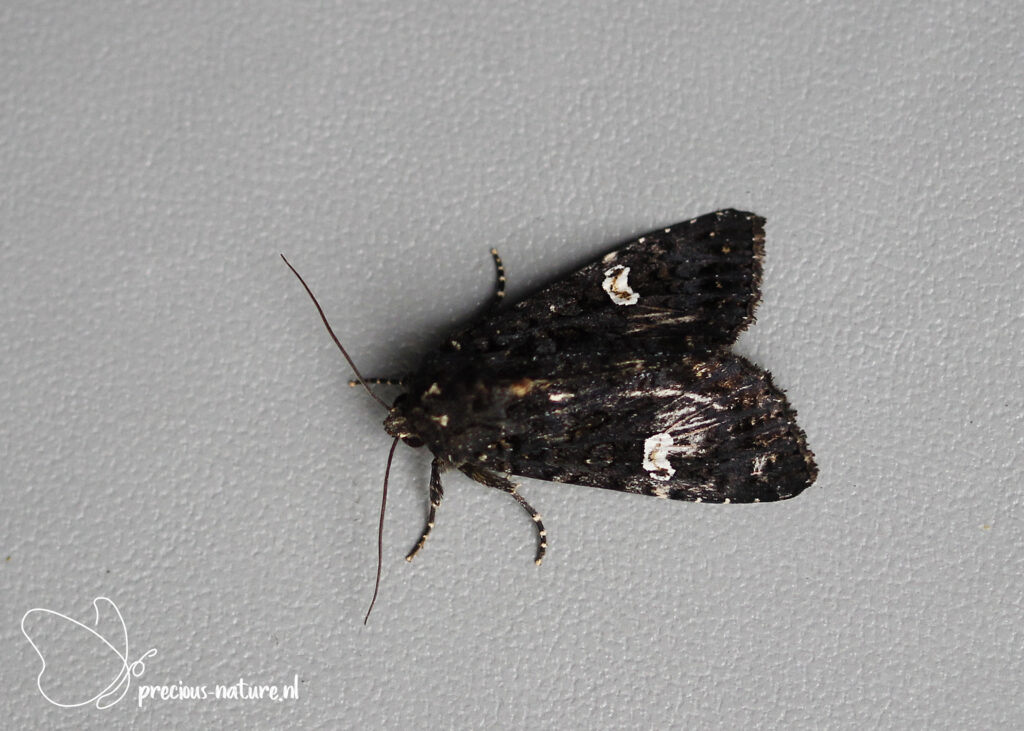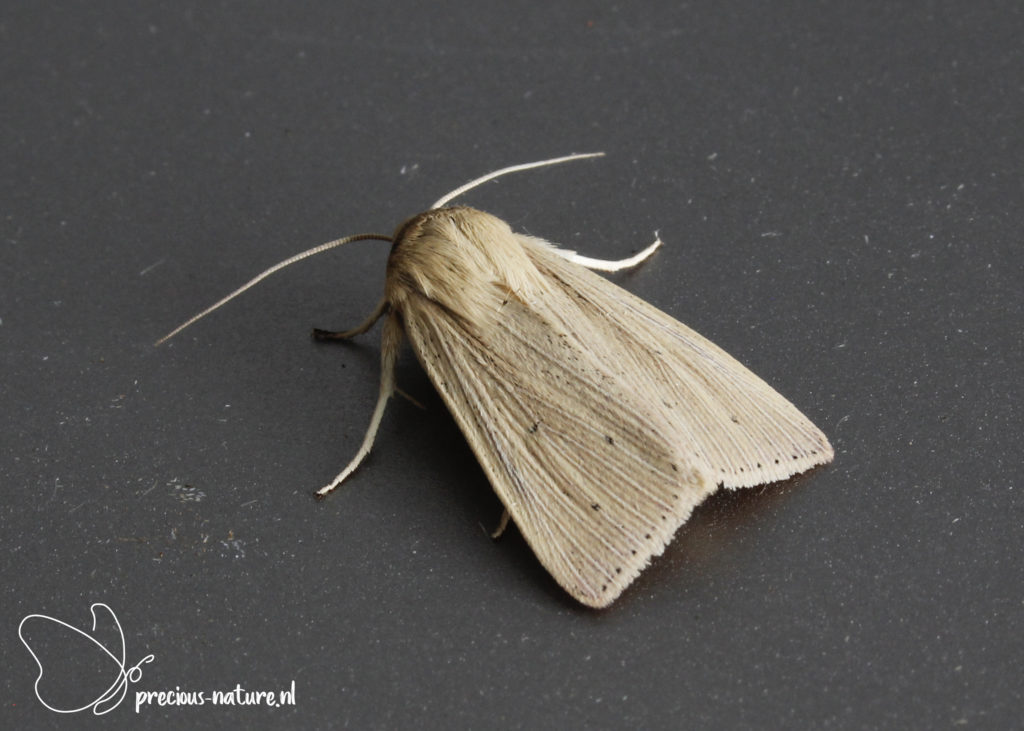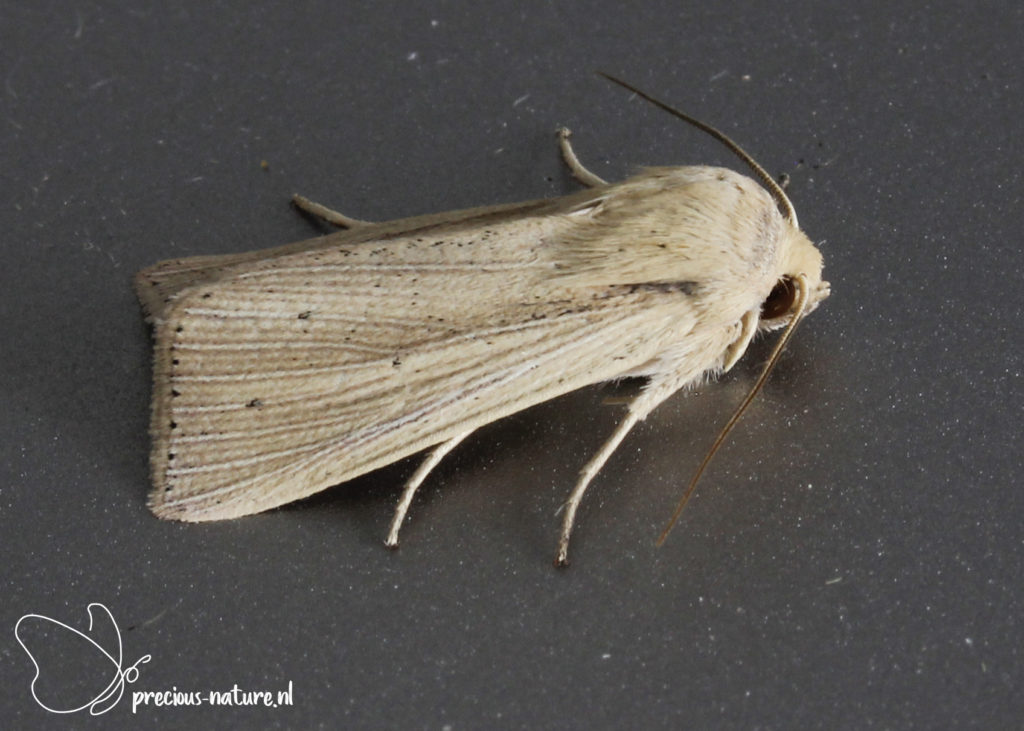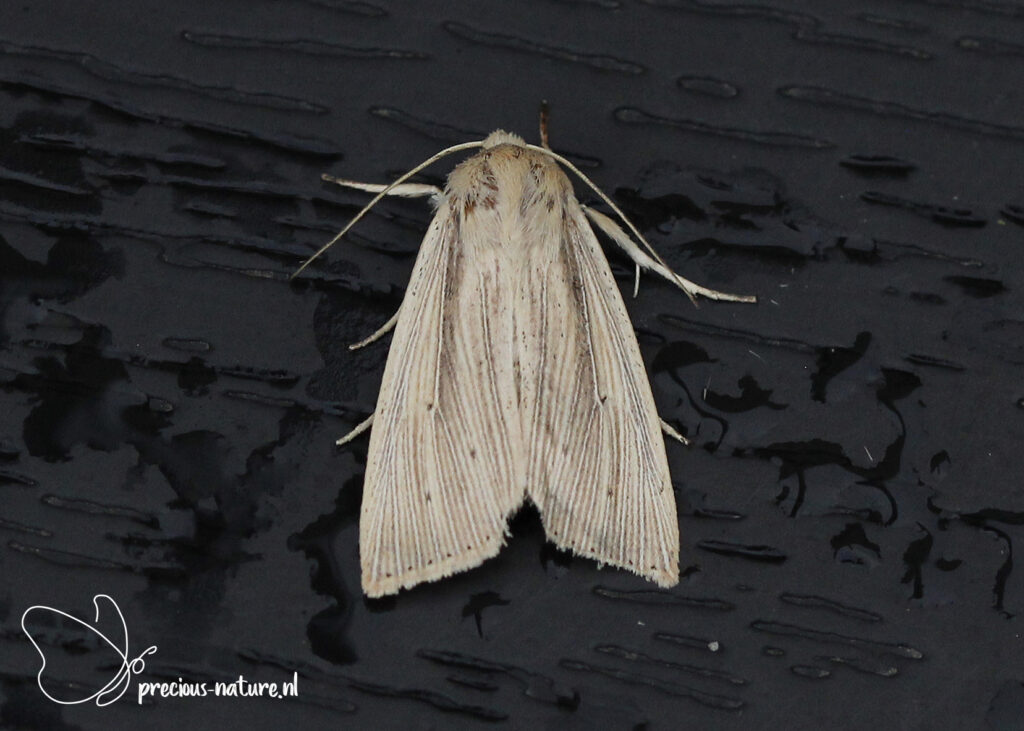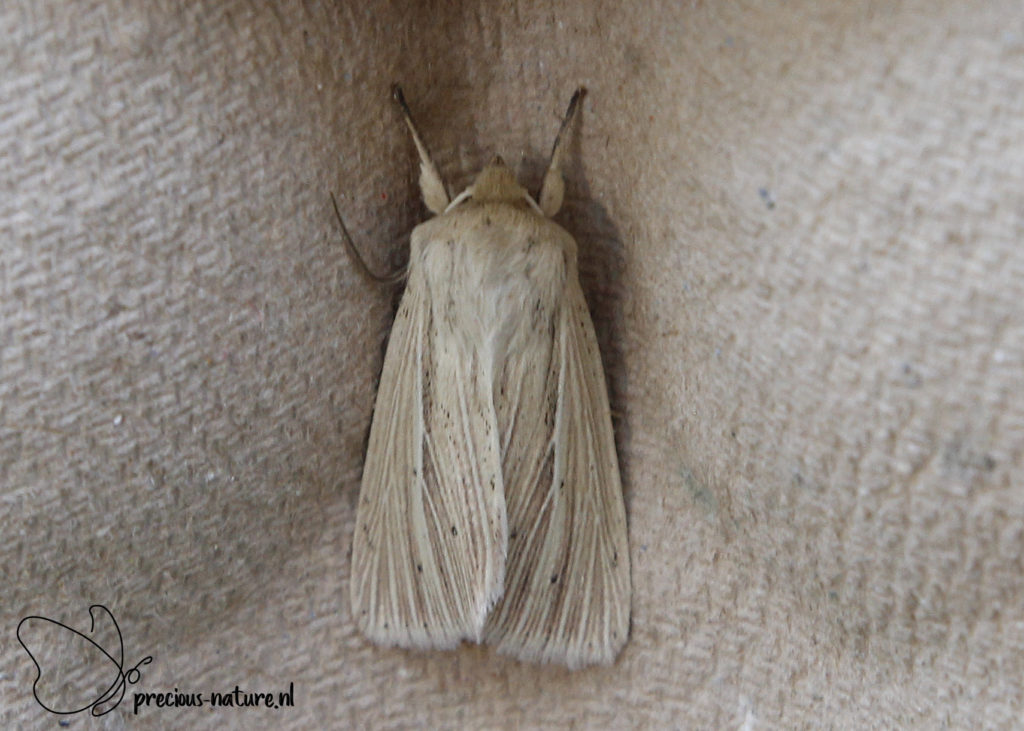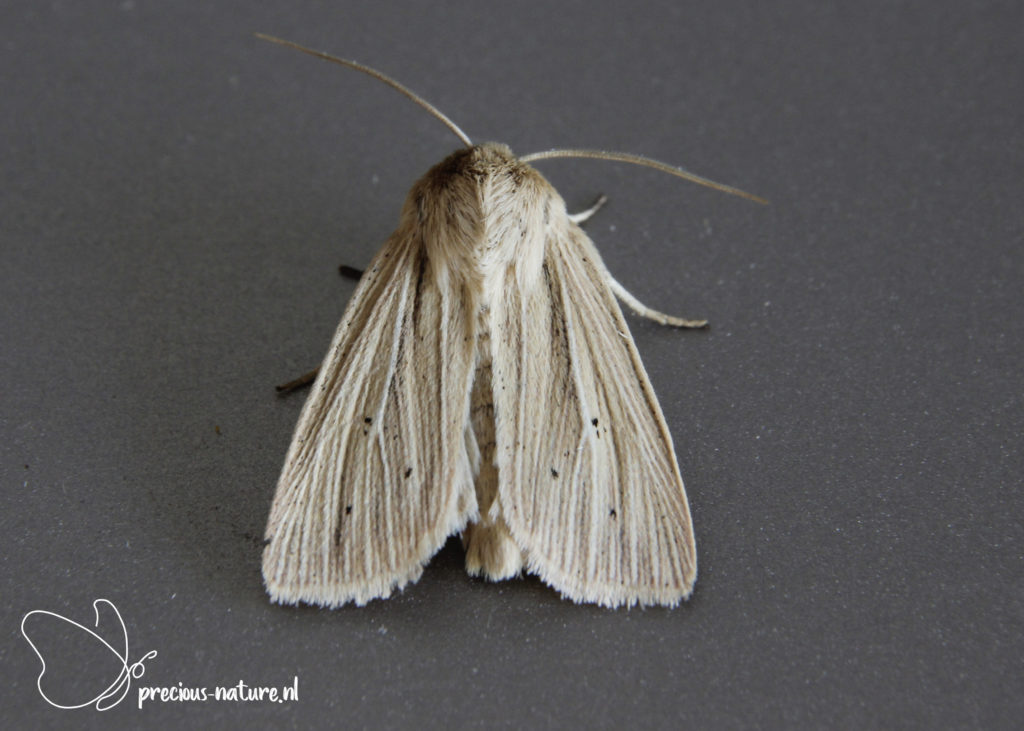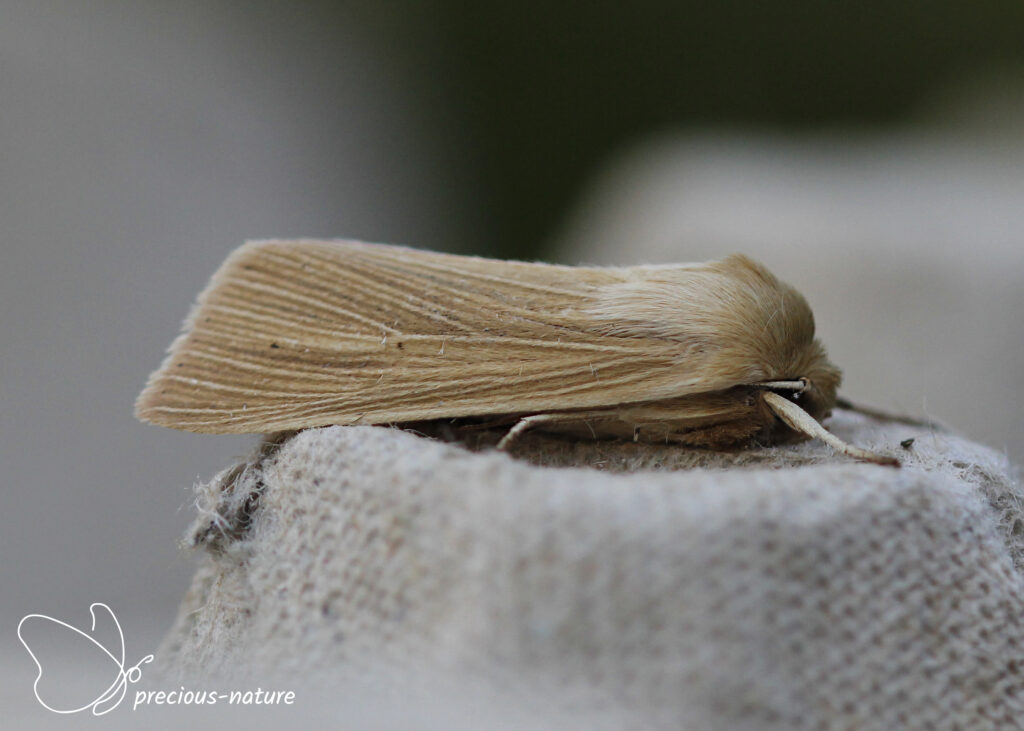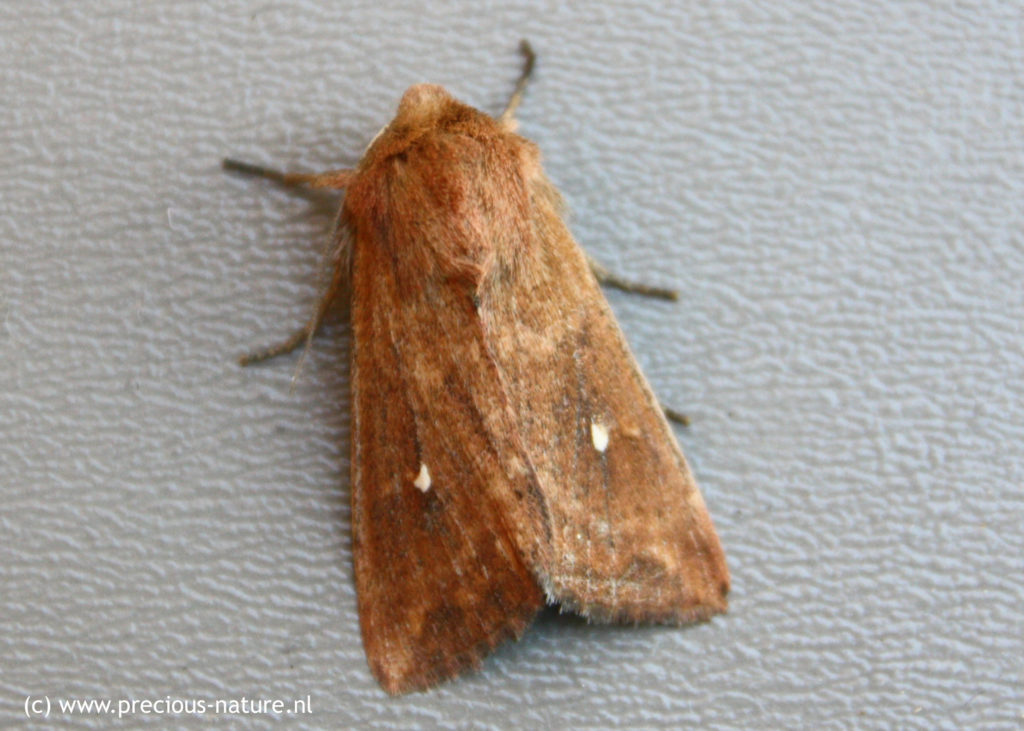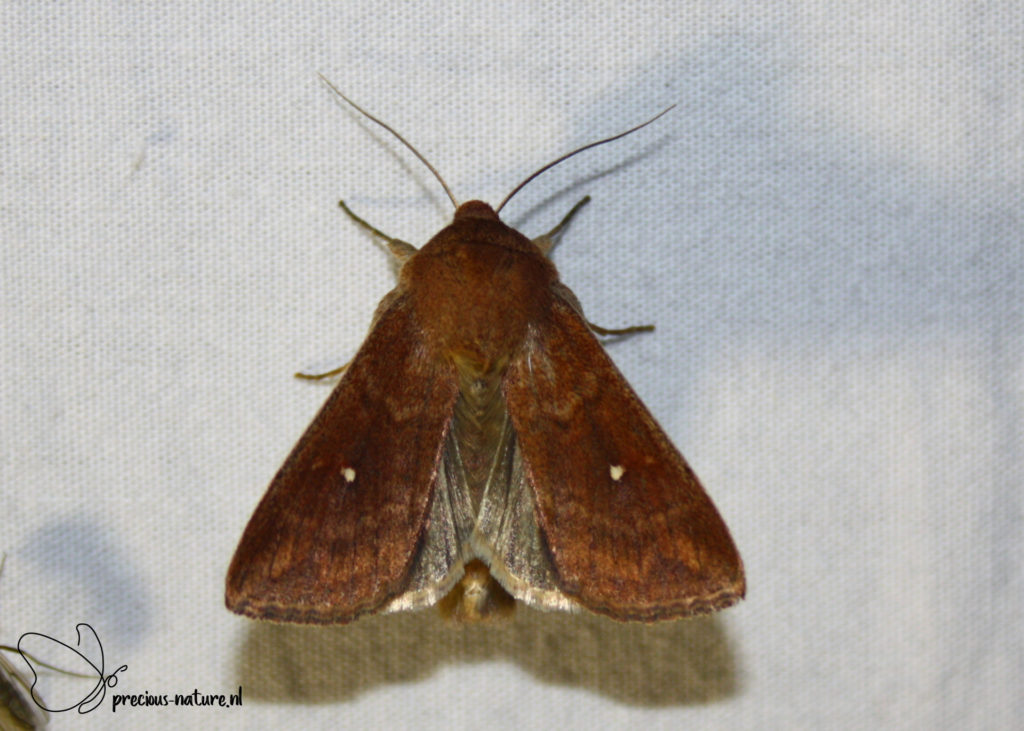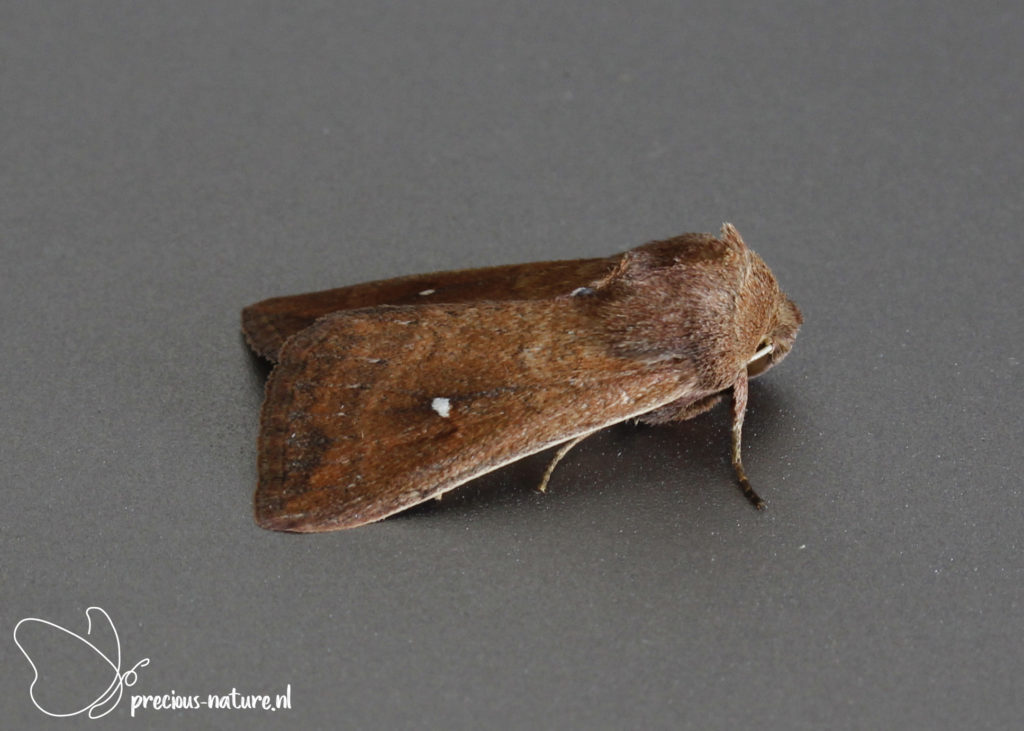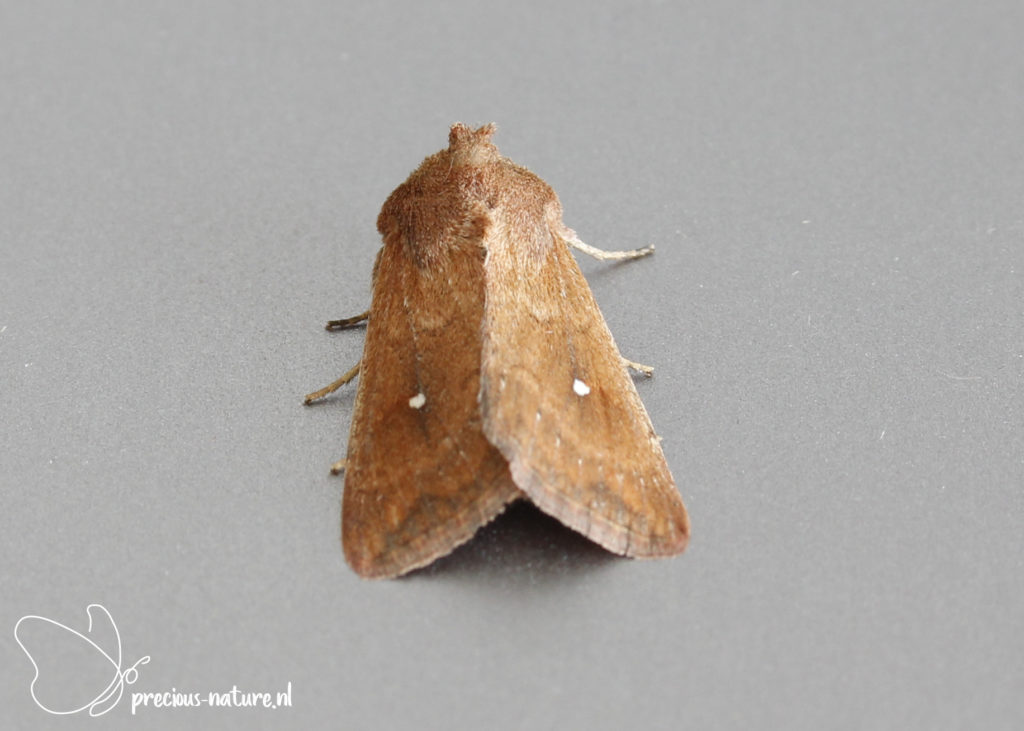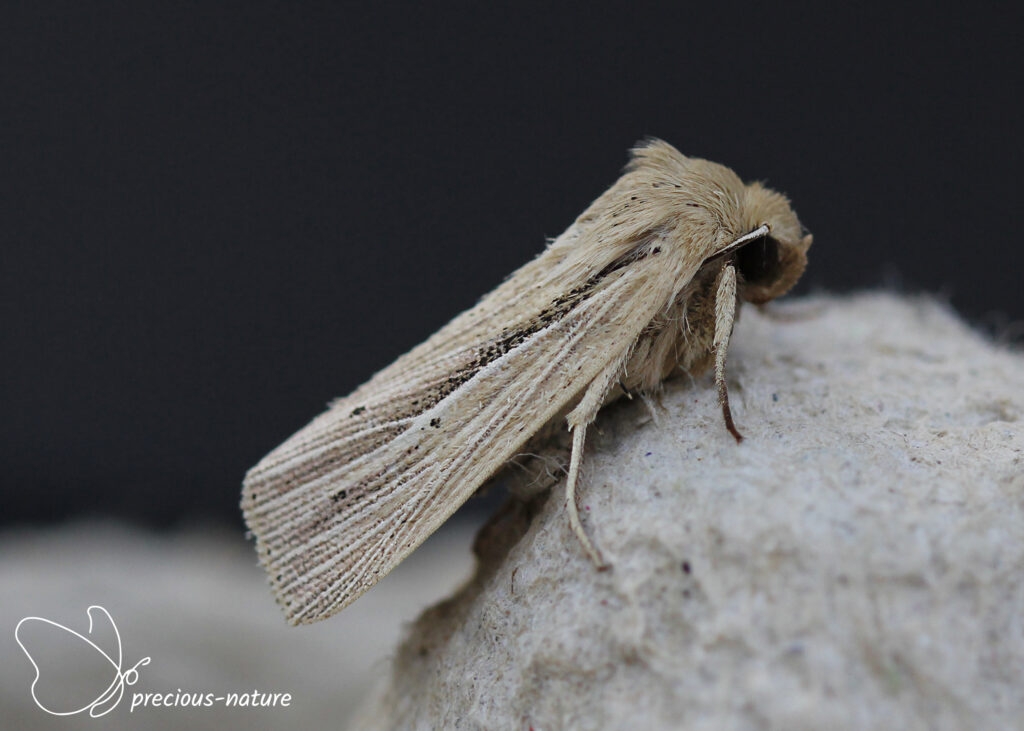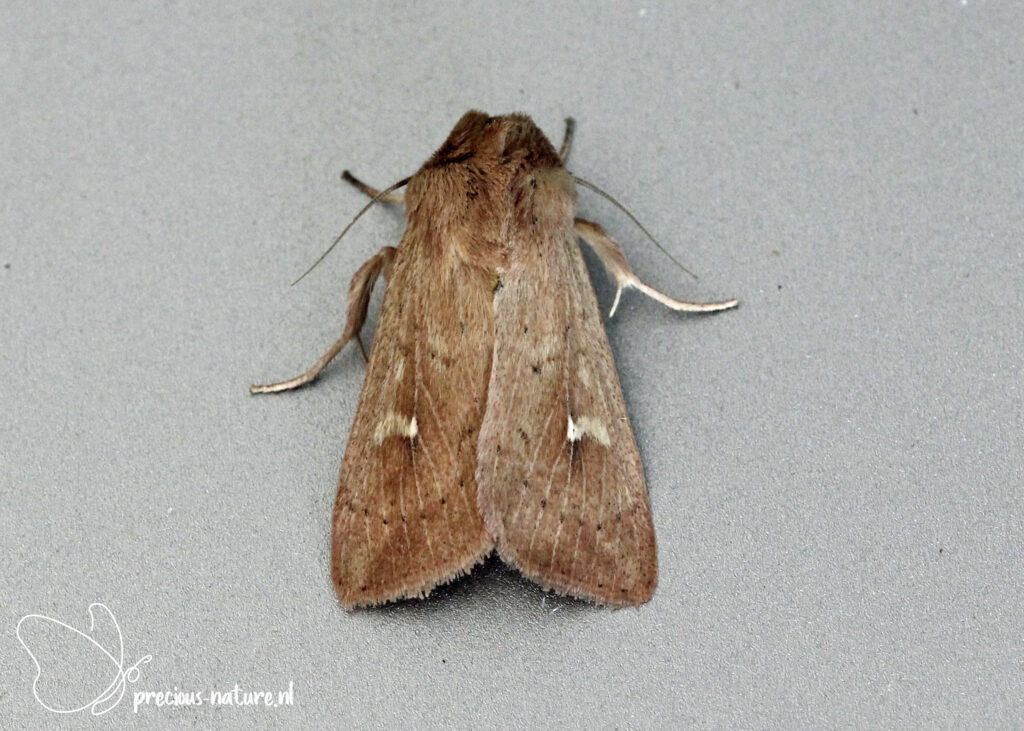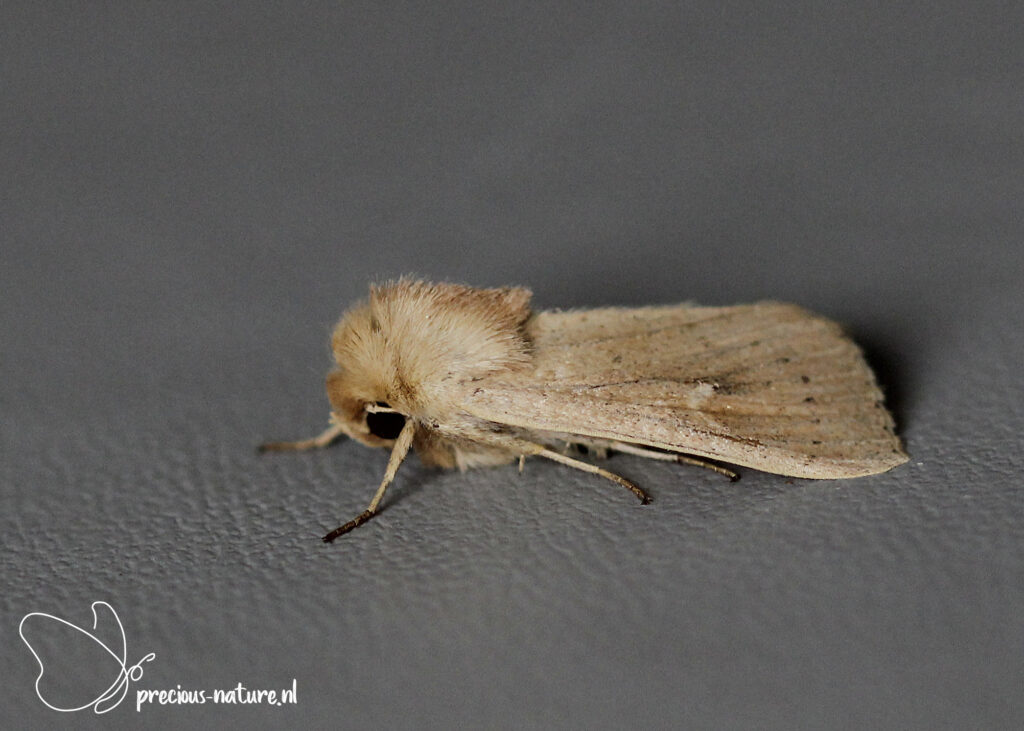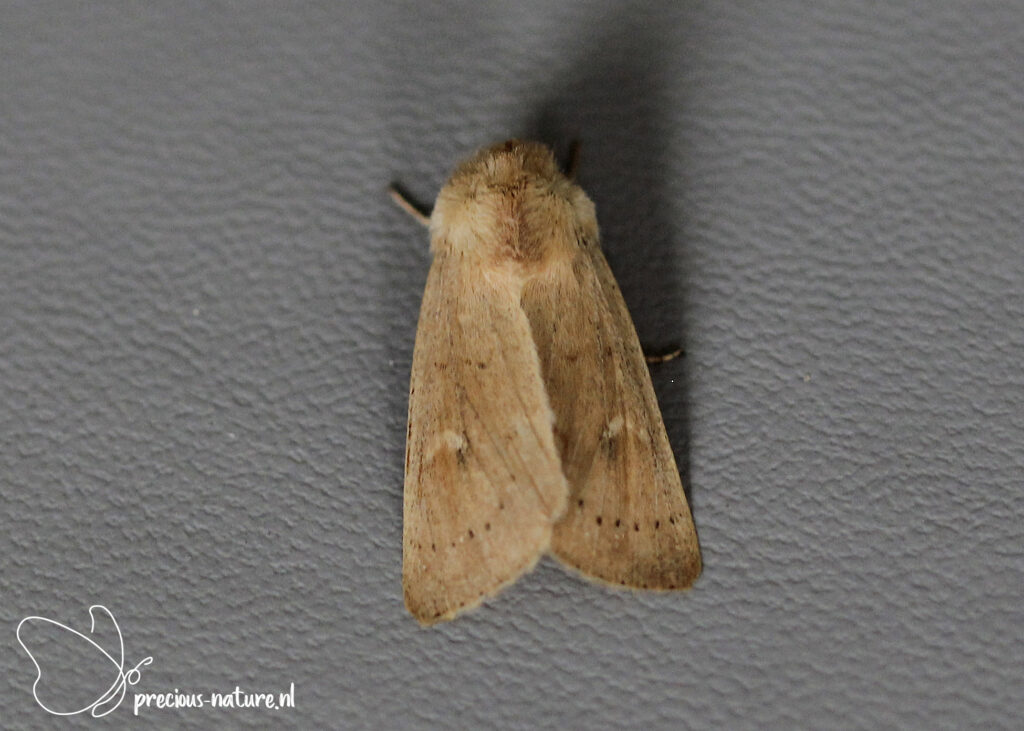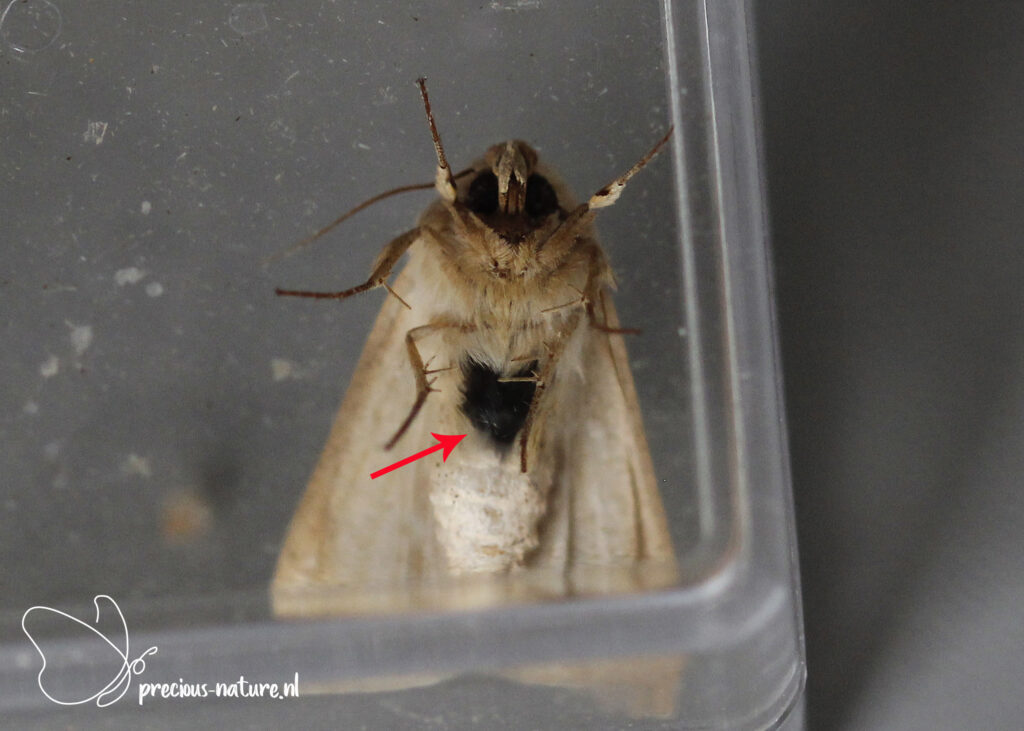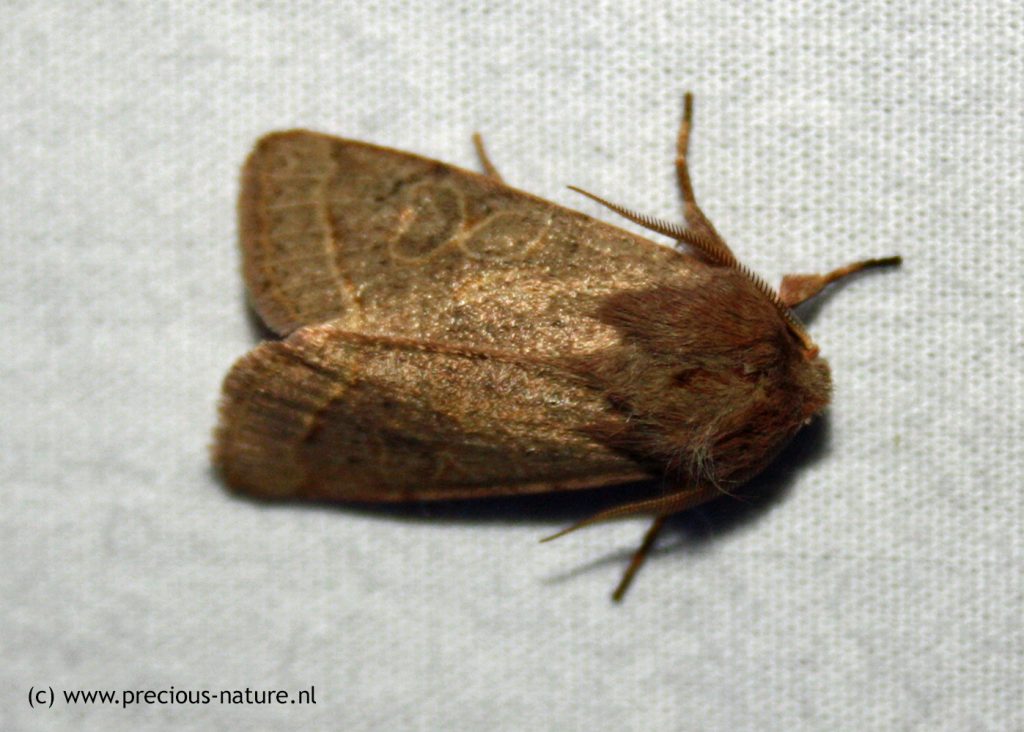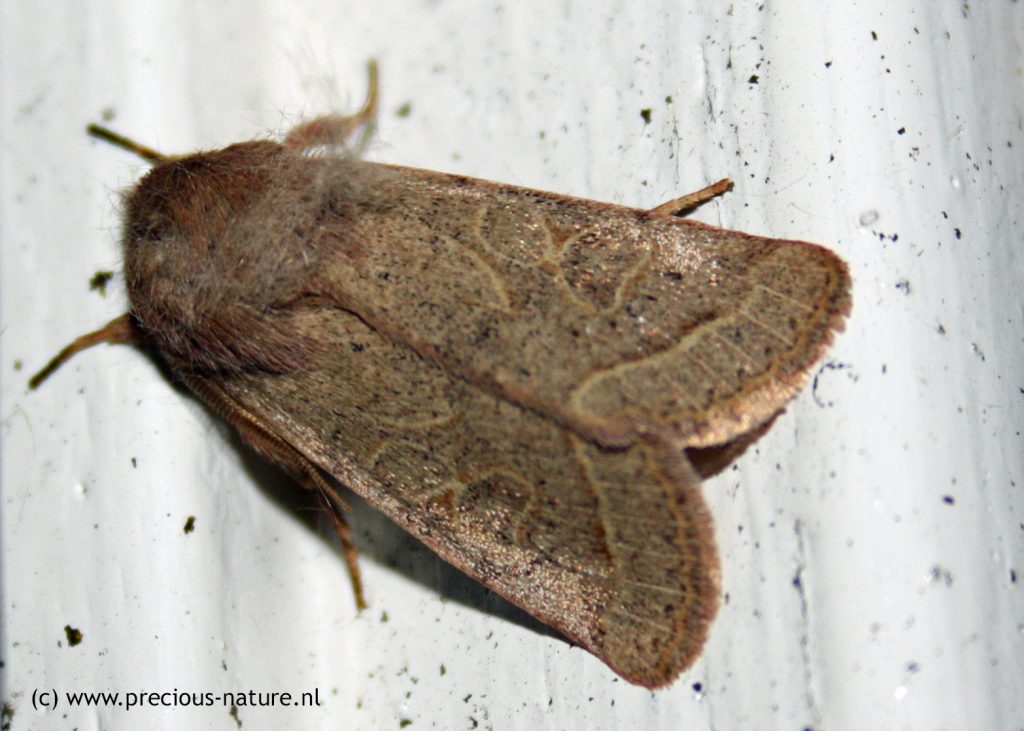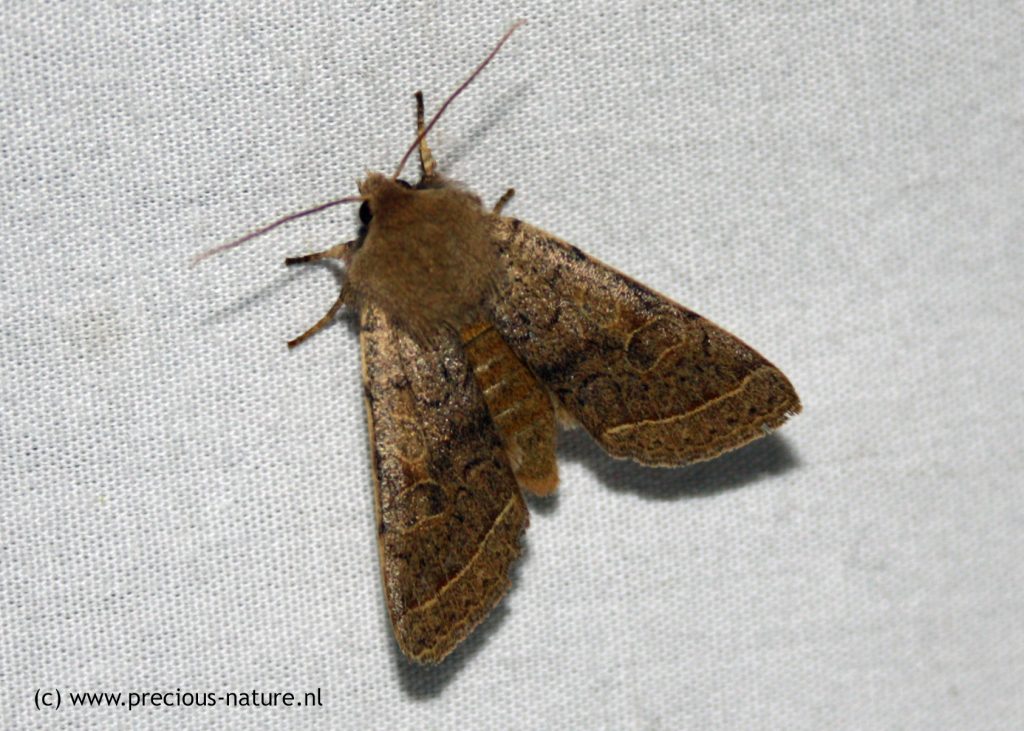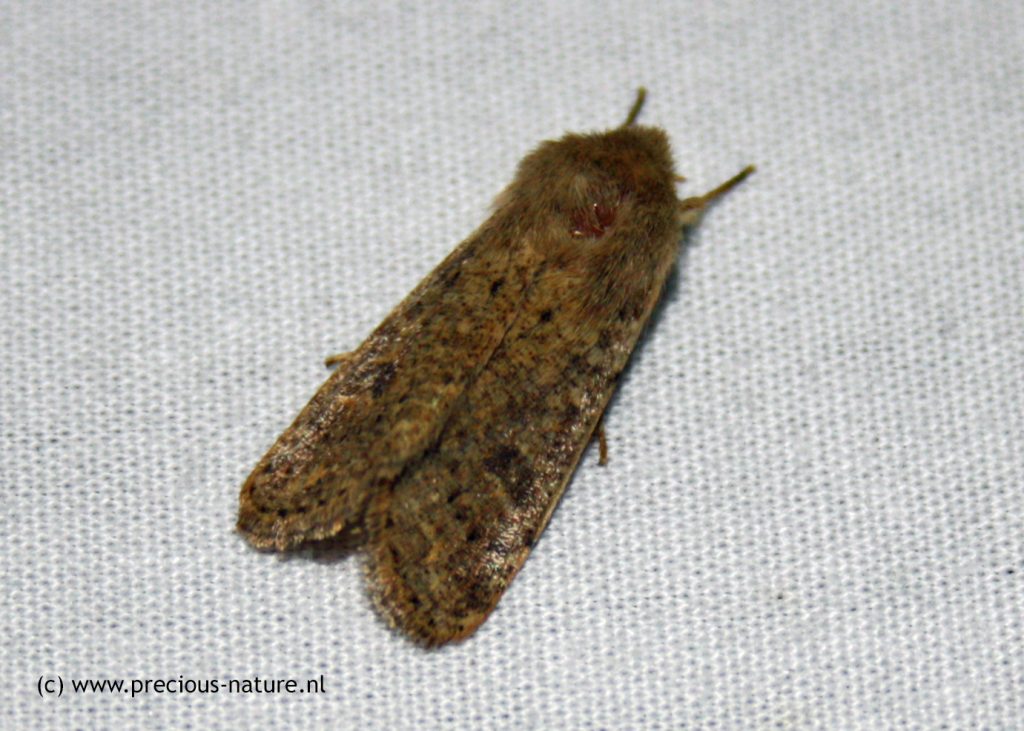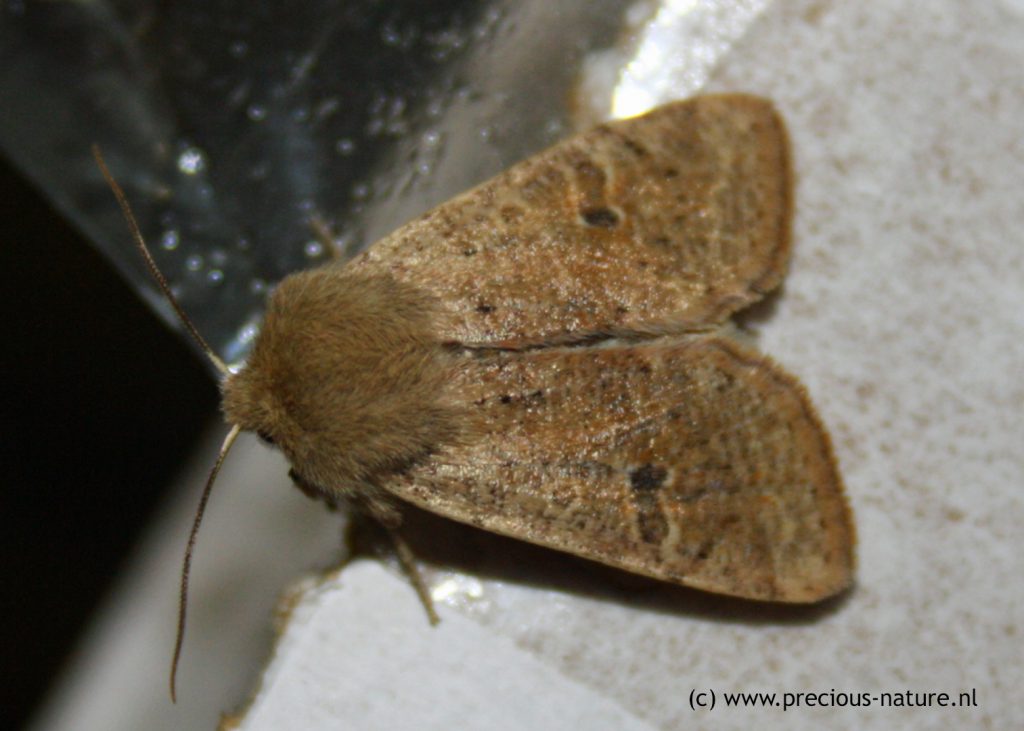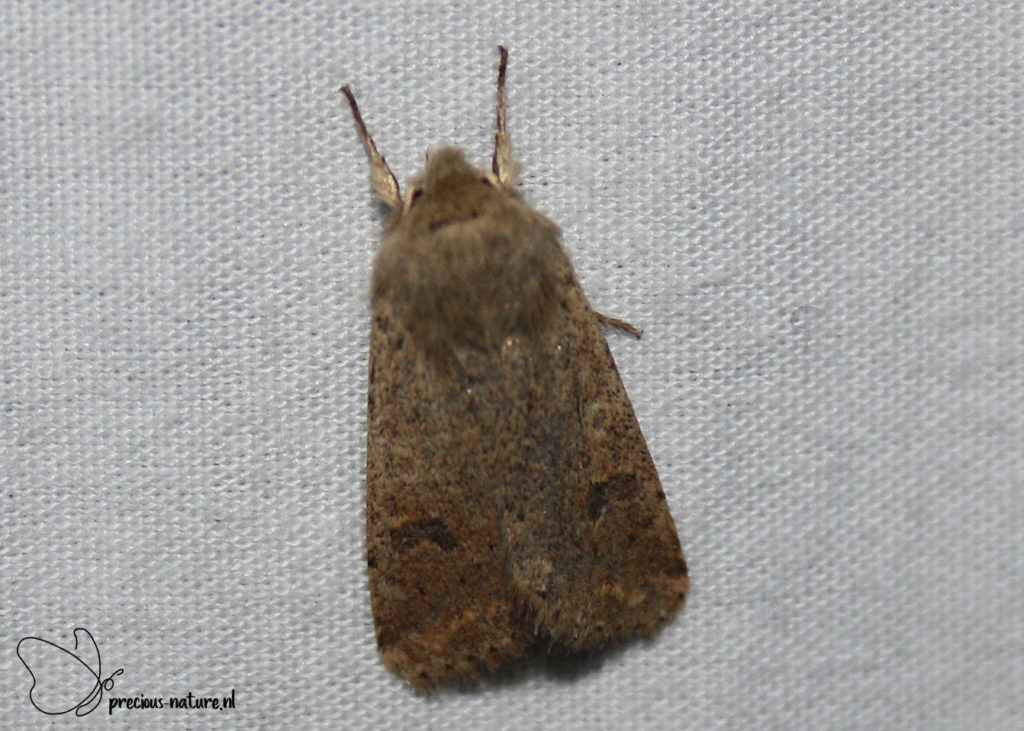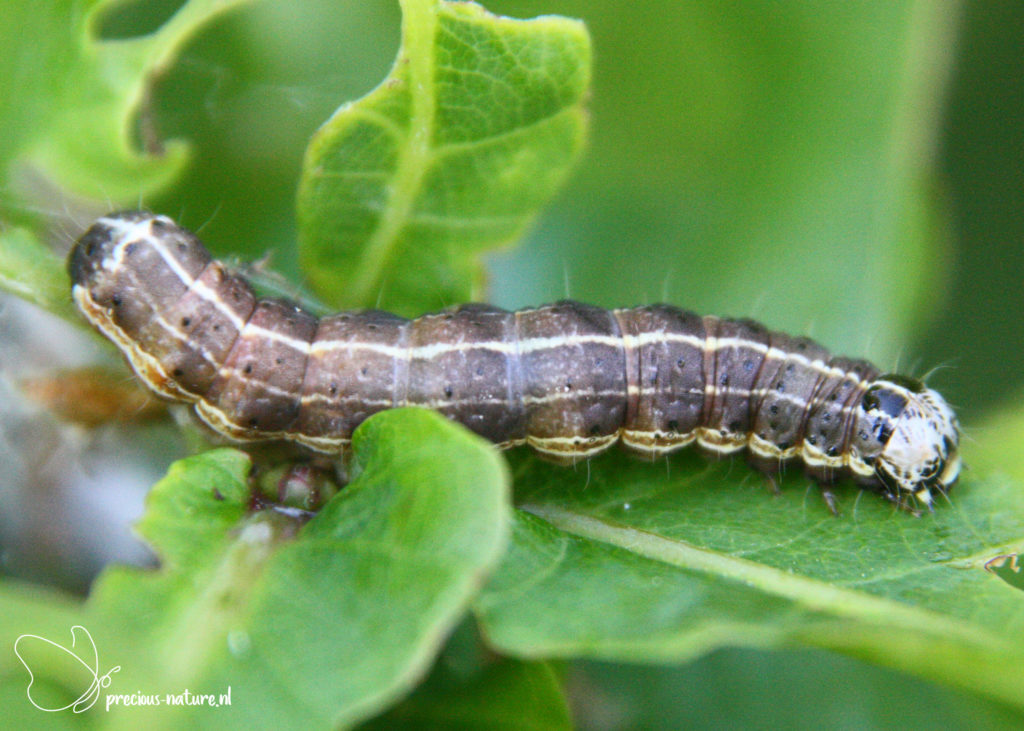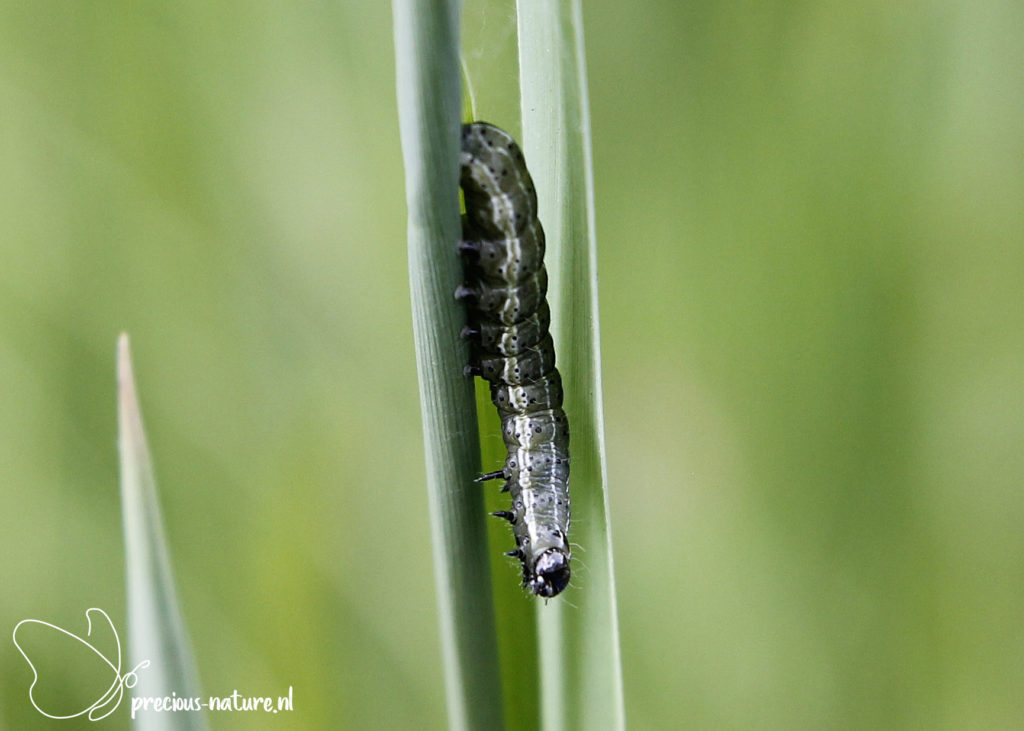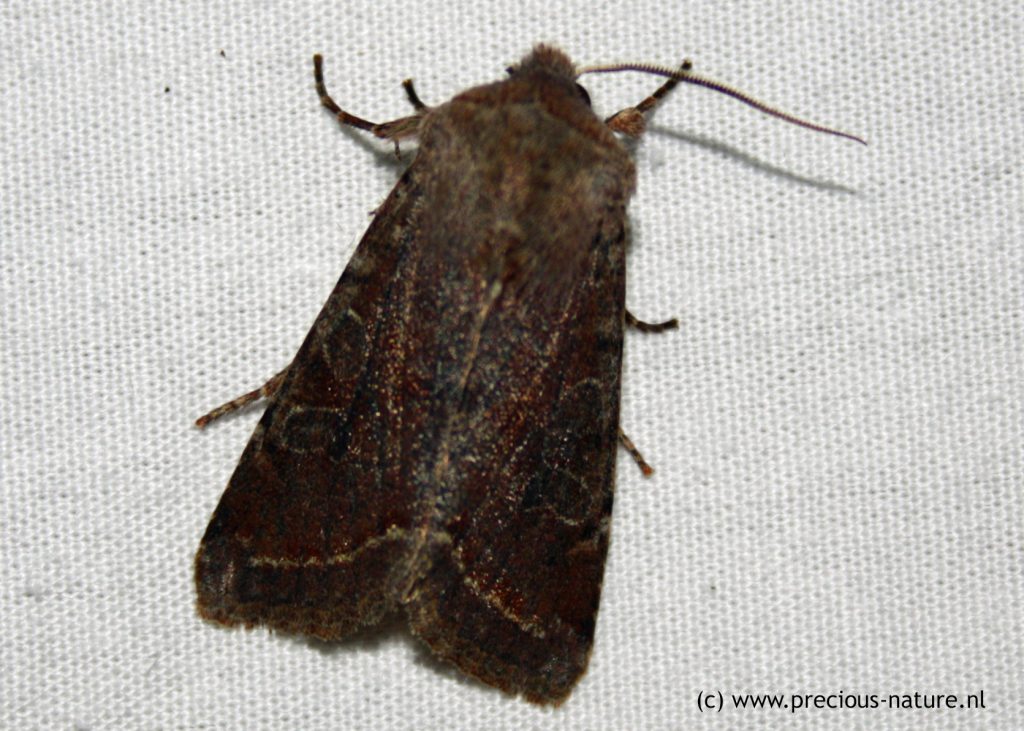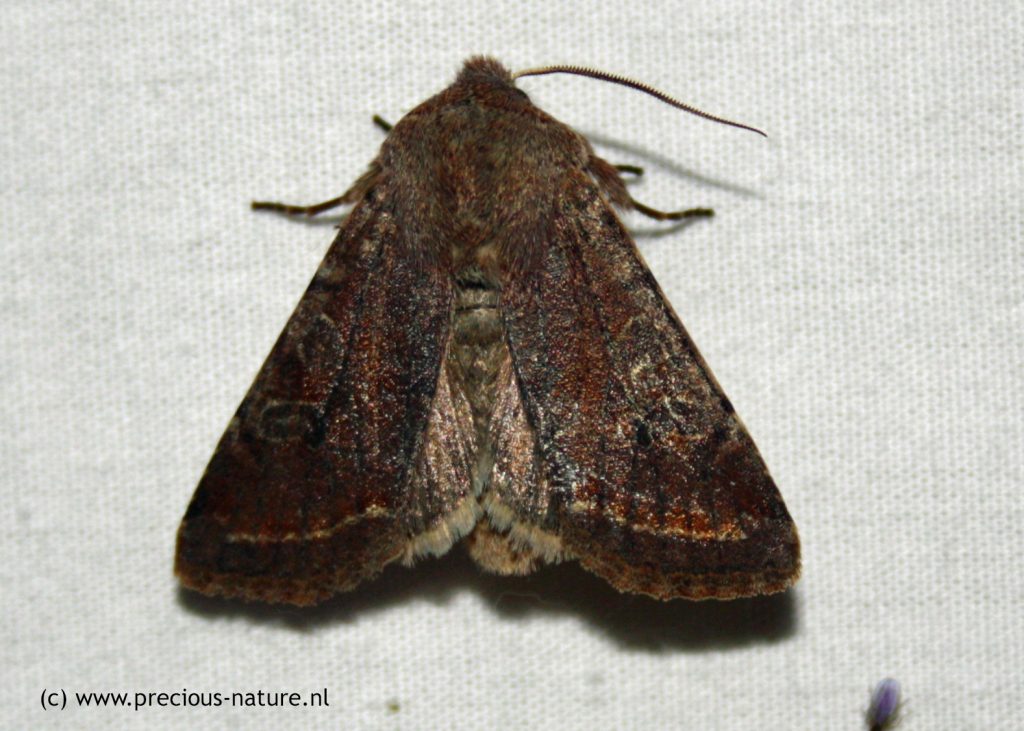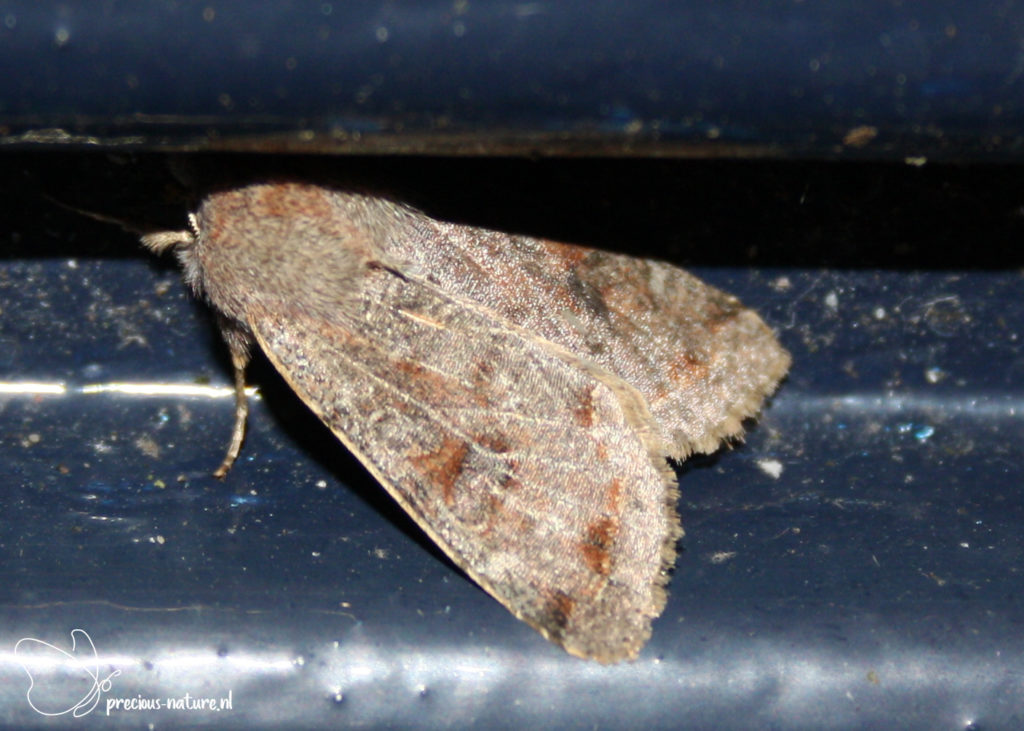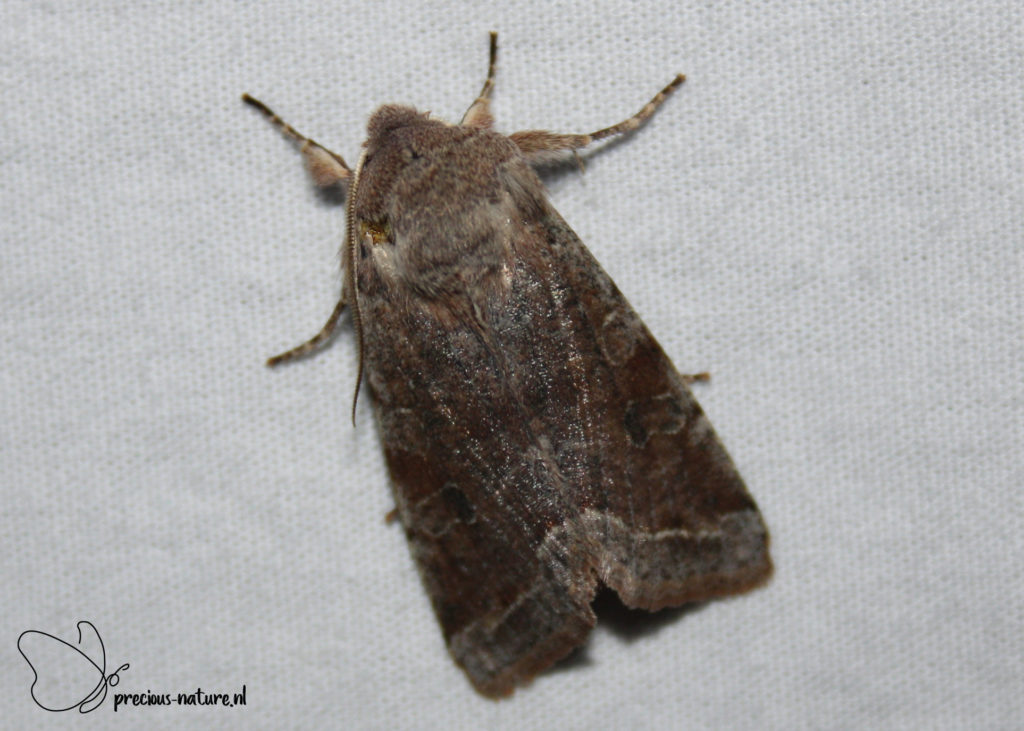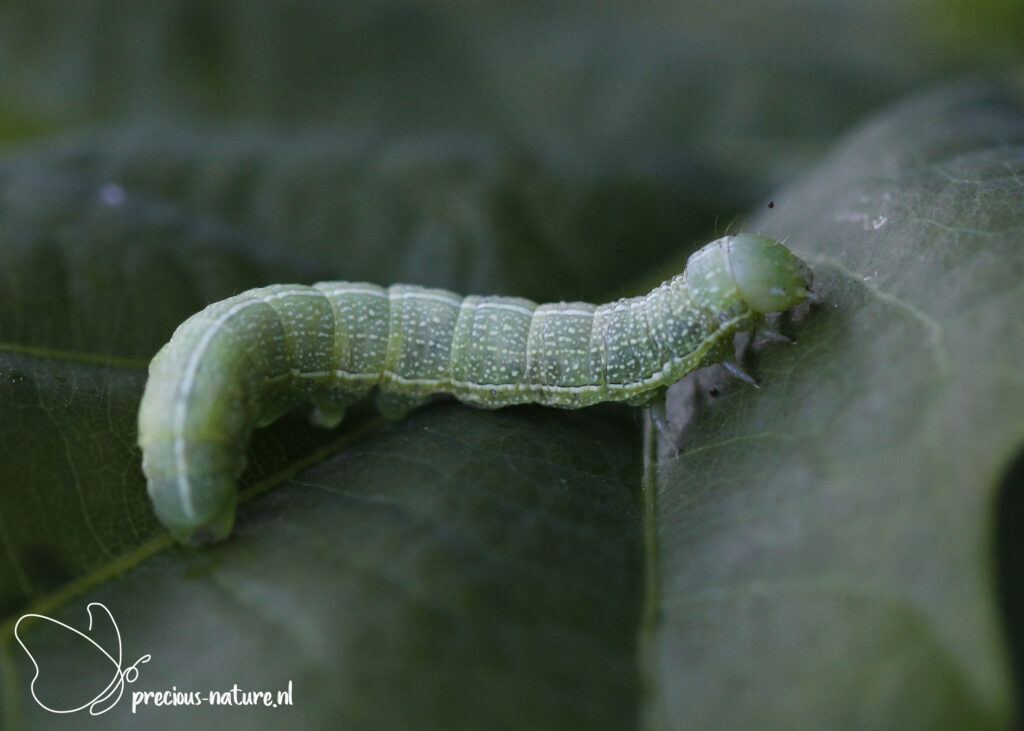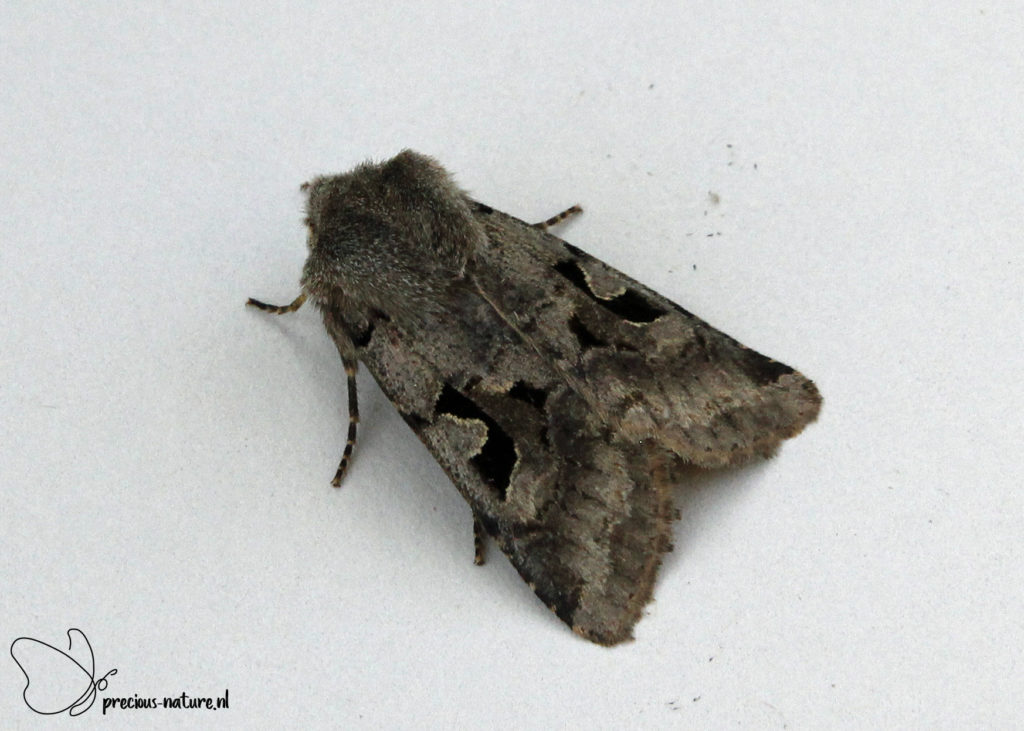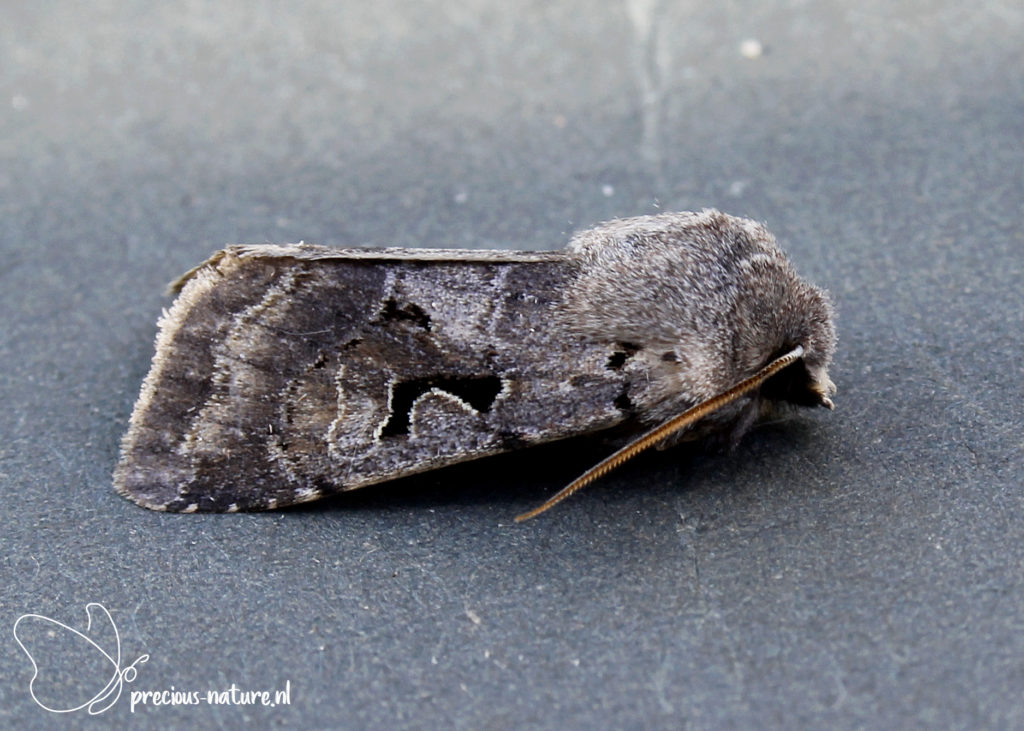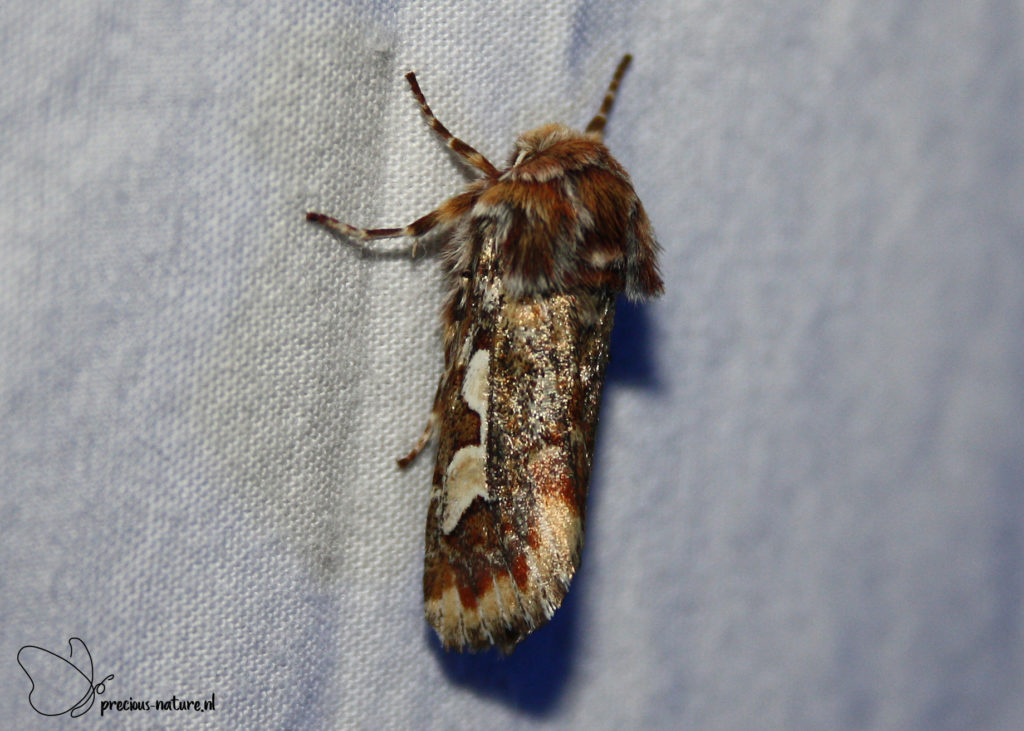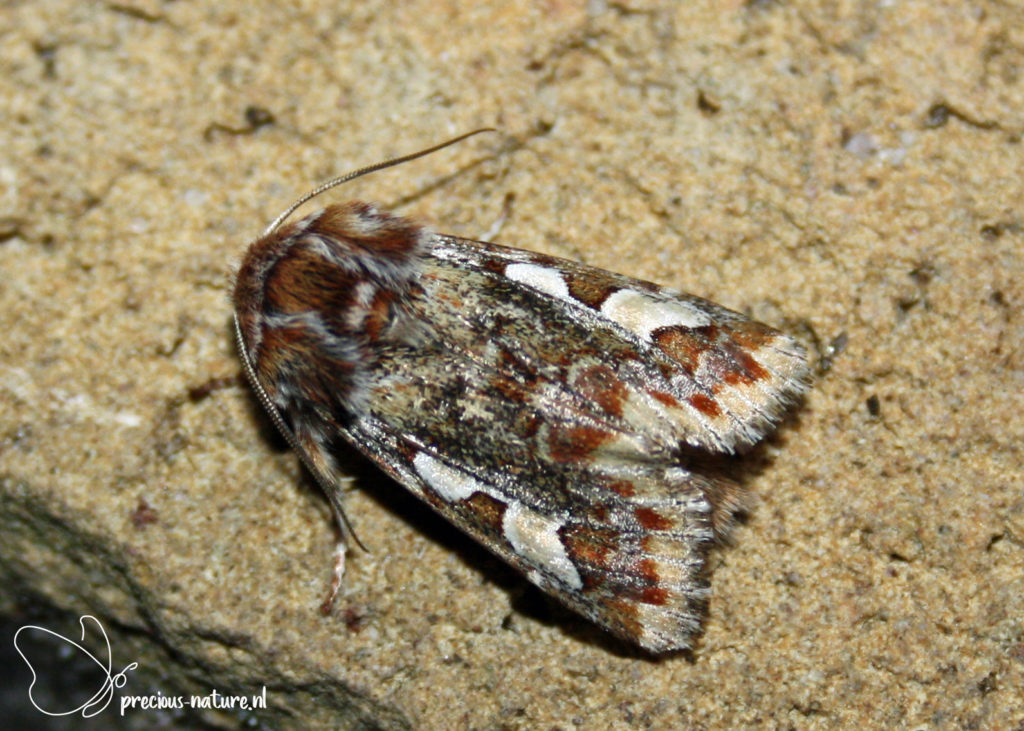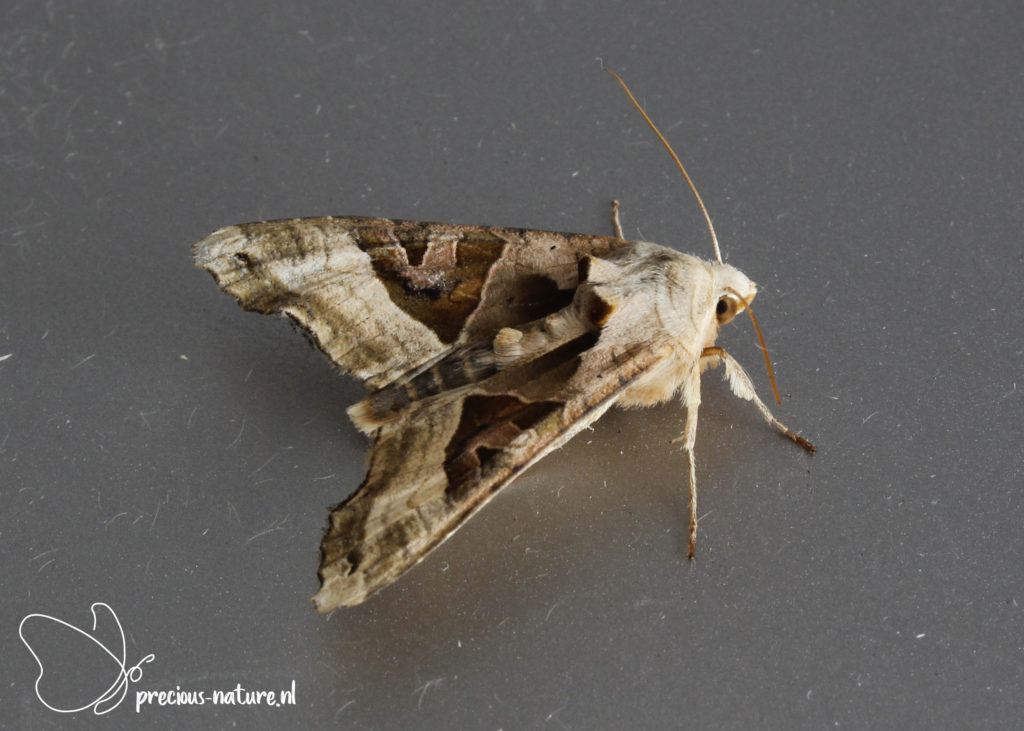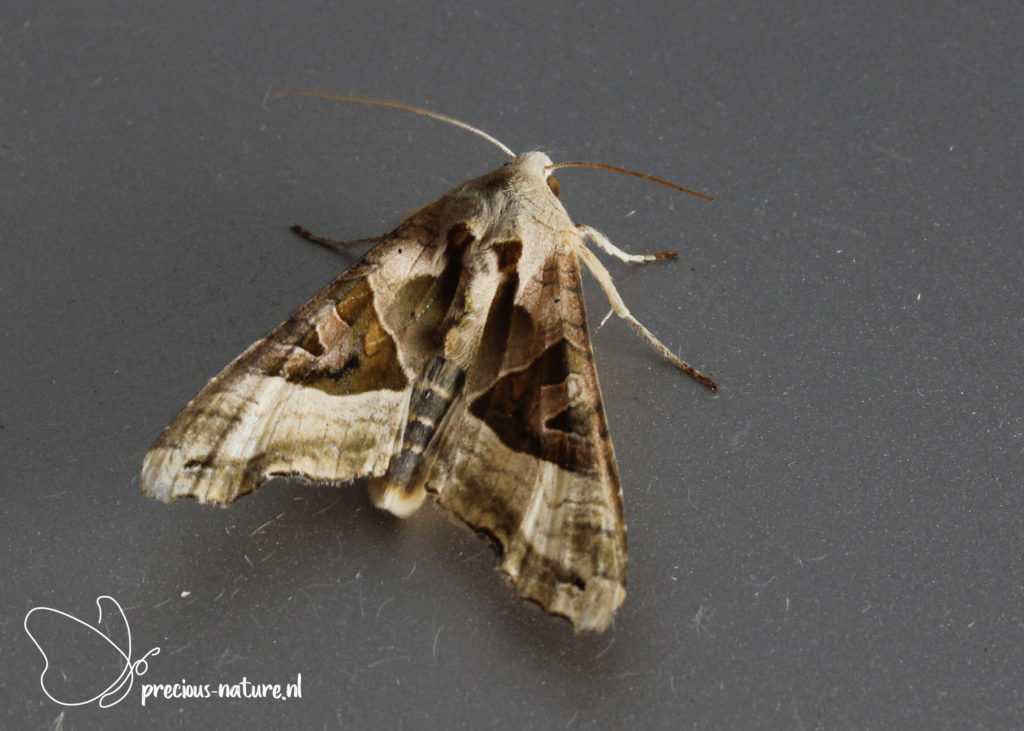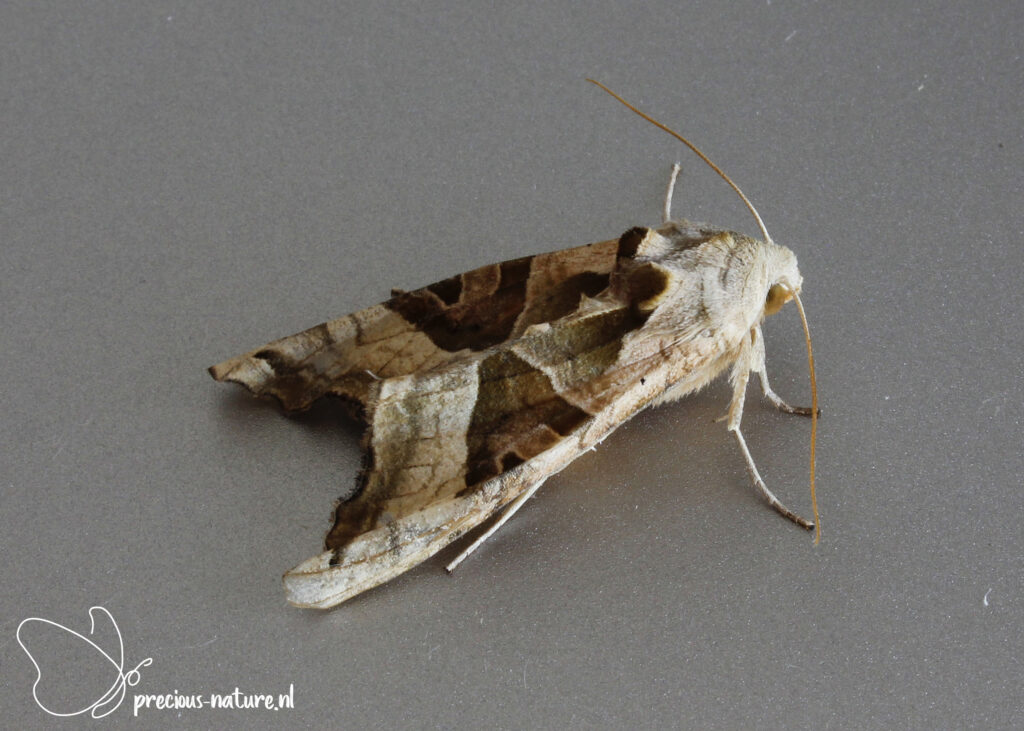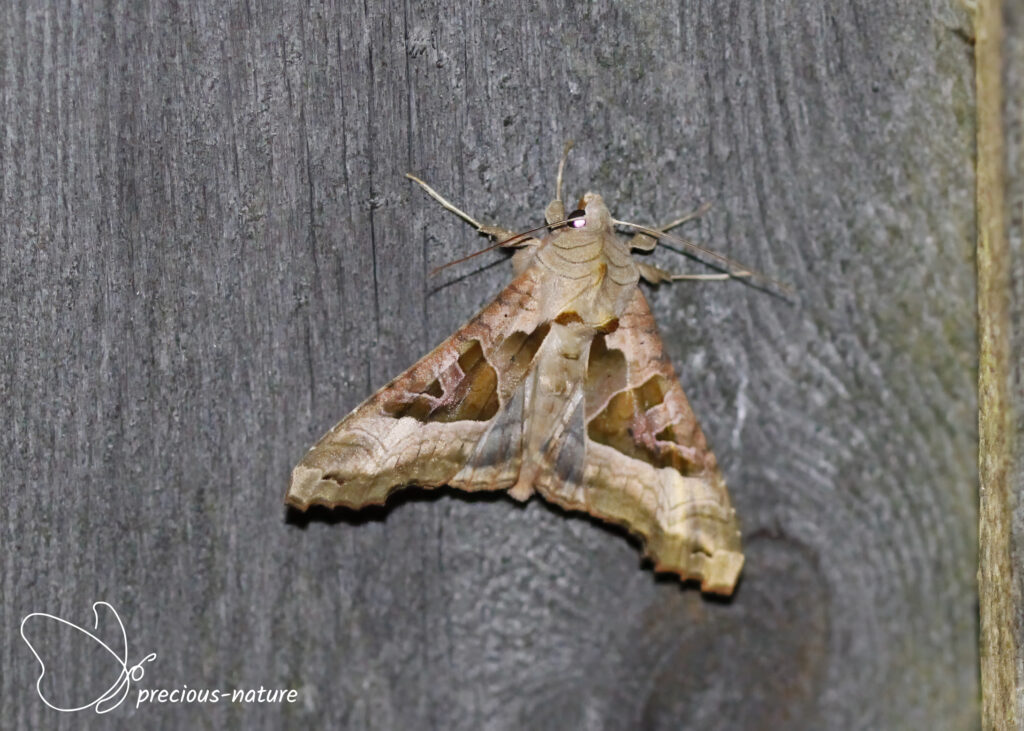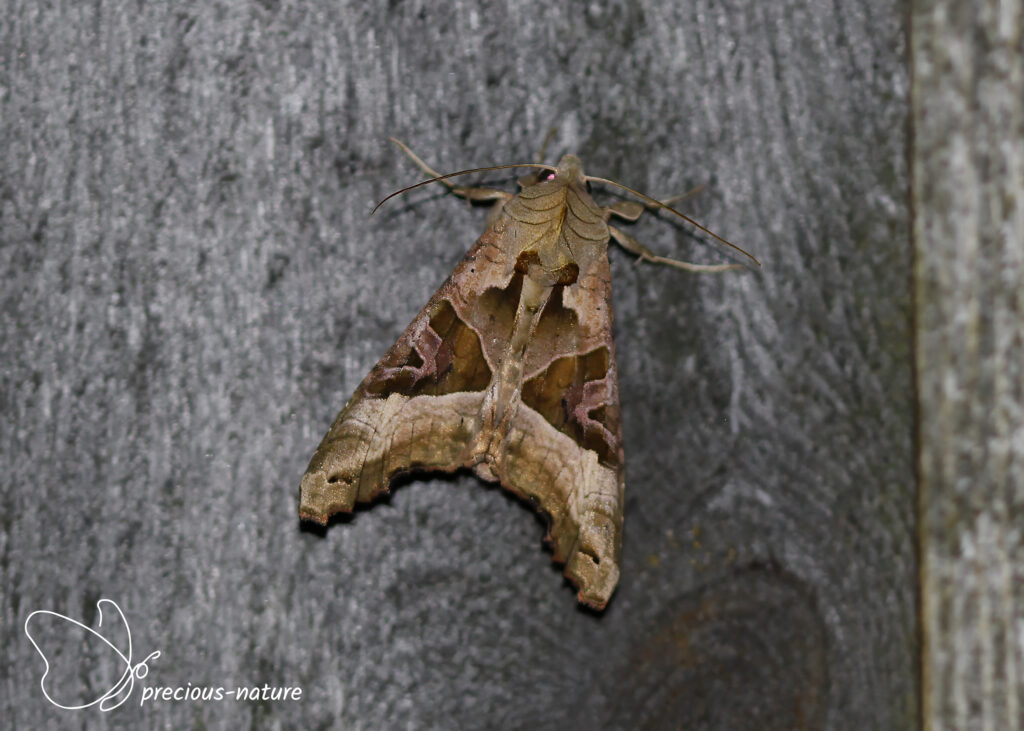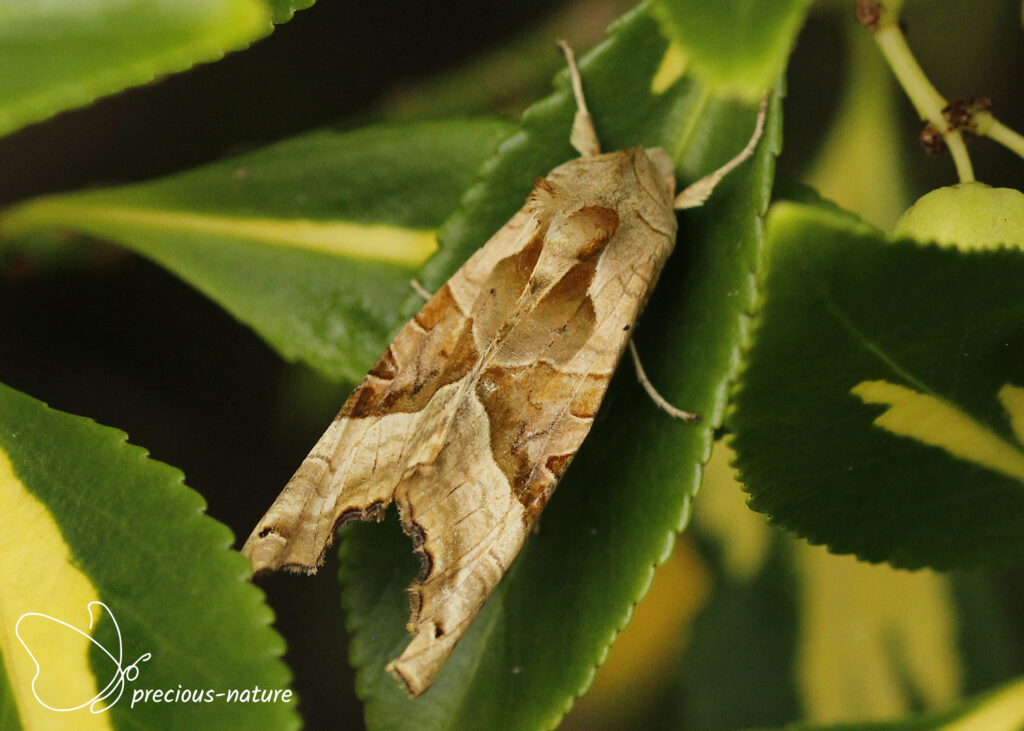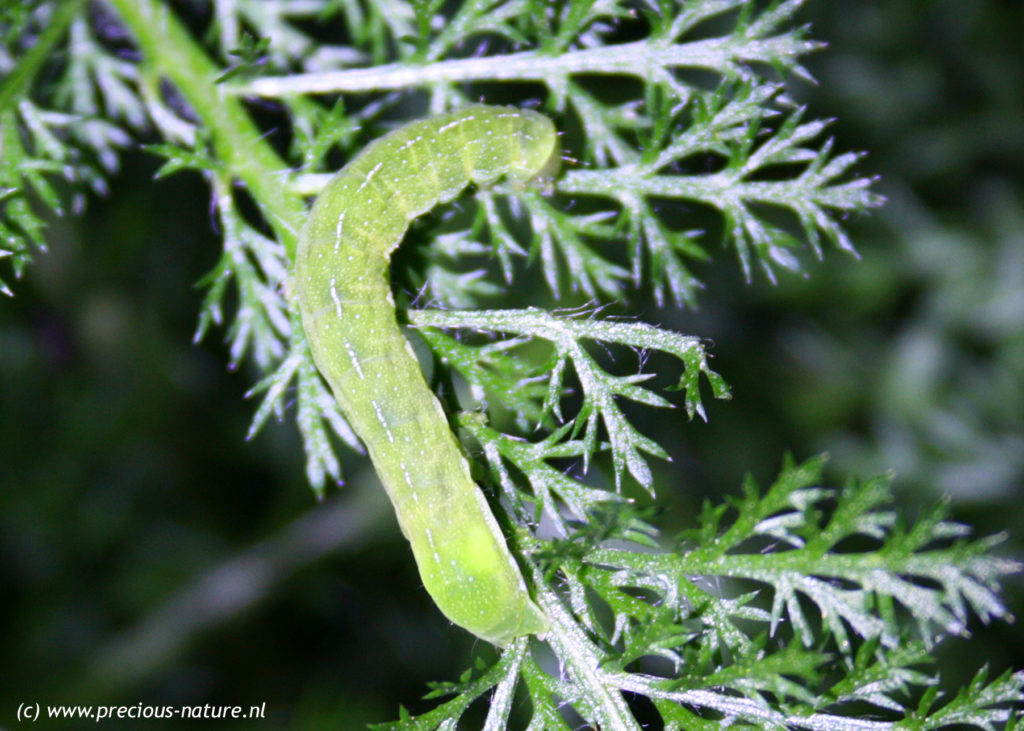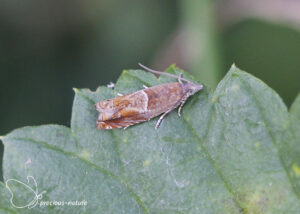Hadeninae is a subfamily of the Owlet Moths (Noctuidae).
Genus: Anarta
The Nutmeg – 2017 (NL)
(NCBI-index: 987454)
An essential characteristic of the Nutmeg (Anarta trifolii) is the clear white ‘W’ in the light, black-deposited wave line. The ground colour is brownish-light to dark grey. The inner lobe of the reasonably large kidney mark is always darker than the base colour of the wing. The midfield and apex are lighter colored. The flight period is from mid-April to mid-October in two and sometimes three generations, and its wingspan is 30-35 mm. Host plant: Orache, Goosefoot. Dutch name: Spurrie-uil. Frisian name: Sparjeûltsje.
Flying period:

Genus: Anarta
Marbled Nutmeg – 2024 (CH)
(NCBI-index: 987453)
Owlet moths are often challenging to identify. Specific characteristics usually provide a good indication of the genus. The white wavy line with a W always points to the Anarta genus. For the Marbled Nutmeg (Anarta odontites), it was a bit of a puzzle because the photo was not sharp. In addition to the host plant on which I saw it sitting, the ring spot is particularly characteristic. The bright white ring with a slightly darker core stands out in the light stripe that runs inwards from the front edge. The upper side of the thorax is hairy with a striking white transverse stripe close to the head. The flight period is two generations from April to the end of July, and the wingspan is 30-34 mm. Host plant: Crown Vetch, Horse-shoe Vetch. Dutch name: Witringpijluil. Frisian name: –
Flying period:

Genus: Euplexia
Small Angle Shades – 2020 (NL)
(NCBI-index: 987933)
Like the Angle Shades (Phlogophora meticulosa), the Small Angle Shades (Euplexia lucipara) has a resting position that makes it look like a dead leaf. The costa is folded under the rest of the wing, and the apex is downwards. The Small Angle Shades can be recognised by the white to pale yellow kidney mark that is located on the border of the dark median band and the broad light brown or pink-brown zone at the dorsum. In that broad light brown zone, the golden yellow spot near the kidney mark is noticeable. The wingspan is 27-32 mm, and the flying period is from May to August in one generation. Host plant: Fern, Birch. Dutch name: Levervlek. Frisian name: Leverflek.
Flying period:

Genus: Hadena
Varied Coronet – 2021 (NL)
(NCBI-index: 987949)
A less dull-colored and marked owlet moth is the Varied Coronet (Hadena compta). The forewing is chocolate brown with black spots and a striking white median band. The white median line extends from the centre of the costa to the dorsum, including the white oval mark, which is partially outlined in black. The darkly outlined white kidney mark lies against this white median line. The Varied Coronet is well distinguishable from the Marbled Coronet (Hadena confusa) and the White Spot (Hadena albimacula) because of the completely continuous white median line. The wingspan is 25-30 mm, and the flight period is from May to August in one generation. Host plant: Sweet William. Dutch name: Witband-silene-uil. Frisian name: –
Flying period:

Genus: Hadena
The Lychnis – 2023 (NL)
(NCBI-index: 987947)
The Lychnis (Hadena bicruris) has predominantly grey-brown and fairly broad forewings. The dark tap spot and elongated, white-lined, narrow ring and kidney spot can be seen on the forewing. The ring spot and kidney spot converge towards the posterior edge, forming a V shape. The two spots rarely merge. The hindwings are grey with a lighter base. The ring spot is quite elongated. The flight period is in two, sometimes three generations, from the end of April to the end of September, and the wingspan is 30-40 mm. Host plant: Red Campion, Sweet Daisy. Dutch name: Gewone silene-uil. Frisian name: –
Flying period:
![]()
Genus: Lacanobia
Bright-line Brown-eye – 2018 (NL)
(NCBI-index: 79499)
An owlet moth I come across more often on insect control websites is the Bright-line Brown-eye (Lacanobia oleracea). This concerns the laying of their eggs on crops that are grown in greenhouses. This rusty brown owlet moth has a ringed white spot and an orange-yellow spot in the dark kidney mark (the brown-eye). Characteristic is the clear white wavy line with the ‘W’ in it (bright line). The flight period is from April to October in two or sometimes three generations, and the wingspan is 28-38 mm. Host plant: Common Nettle, St. John’s wort, Hazel, Willow, and hops. Dutch name: Groente-uil. Frisian name: Grienteûltsje.
Flying period:

Genus: Lacanobia
Dog’s Tooth – 2021 (NL)
(NCBI-index: 987966)
Most noticeable on the front wing of the Dog’s Tooth (Lacanobia suasa) is the blackish-filled short dart mark that stands out as a massive dark spot. The inner part of the kidney spot and the surrounding midfield are often dark. The Dog’s Tooth comes in two colour variations: greyish-brown with sand-colored pollination and an even greyish dark brown showing only the dart mark, the whitish W in the wavy line at the termen and the black stripe in the basal area. The flight period spans two generations, from April to October, and the wingspan ranges from 32 to 37 mm. Host plant: Dock, Plantain, herbaceous plants. Dutch name: Variabele w-uil. Frisian name: –
Flying period:

Genus: Leucania
Shoulder-striped Wainscot – 2019 (NL)
(NCBI-index: 987968)
A solidly built owlet moth with a greyish-brown or dull straw-colored front wing with white veins is the Shoulder-striped Wainscot (Leucania comma). The white central vein ends in the centre of the forewing in a bulge that is roughly comma-shaped. Striking is the deep black shoulder stripe that runs from the base along the white central vein to the midfield. The various blackish stripes in the costal area and the light streak along the costa are also striking. There is a slight variation in colour and markings. The hindwing is brown. The flight period spans one generation from mid-May to late July, and occasionally a second generation from mid-September to mid-October. The wingspan is 32-37 mm. Host plant: Various grasses, especially Cock’s-foot. Dutch name: Komma-uil. Frisian name: Kommaûltsje.
Flying period:

Genus: Mamestra
Cabbage Moth – 2014 (NL)
(NCBI-index: 55057)
The Cabbage Moth (Mamestra brassicae) has a striking white outline of the kidney mark. The outer transverse line is corrugated, with the inner edge also being white. The ground colour of the top of the forewing is otherwise dark grey-brown. It flies in two generations from April to October, and the wingspan is 37-45 mm. Host plant: Cabbage, Willow, Oak. Dutch name: Kooluil. Frisian name: Koalûltsje.
Flying period:

Genus: Melanchra
Dot – 2017 (NL)
(NCBI-index: 987979)
The Dot (Melanchra persicariae) has a black forewing with a striking white kidney mark. A grey half moon can be seen in the kidney mark. Along the costa, often a white, wavy line and some white spots can be seen. The chestpiece often shows a small bunch of reddish-brown hairs. This owlet moth flies in one generation from May to September, and its wingspan is 32-42 mm. Host plant: Common Nettle, Hop, Field Bindweed, Hazel, Elder. Dutch name: Perzikkruiduil. Frisian name: Bultrûpûltsje.
Flying period:

Genus: Mythimna
Southern Wainscot – 2017 (NL)
(NCBI-index: 987989)
The Southern Wainscot (Mythimna straminea) has a forewing with a straight costa, unlike its relatives. The top of the forewing is light yellowish-white with a slightly pinkish hue. A brown streak runs along the pale central vein. The hindwing is white with dark veins and grey speckles. The resembling Smoky Wainscot (Mythimna impura) has more rounded forewings and is missing the grey line over the collar, seen in the front view, which is unique for the Southern Wainscot. It flies in one generation from June to September, and its wingspan is 32-40 mm. Host plant: Reed, Canary-grass. Dutch name: Spitsvleugelgrasuil. Frisian name: Skerpwjukgersûltsje.
Flying period:

Genus: Mythimna
Common Wainscot – 2017 (NL)
(NCBI-index: 987986)
The Common Wainscot (Mythimna pallens) has a forewing with a light yellow to brownish top. Sometimes brown streaks are visible. It has no clear markings other than the white veins. The top of the hindwing is white. The resembling Smoky Wainscot (Mythimna impura) is darker and has a dark grey hindwing. This owlet moth flies in two generations from May to October and has a wingspan of 30-35 mm. Despite being a moth, you will also encounter them during the day while they are resting in the long grass. Host plant: Various grasses. Dutch name: Bleke grasuil. Frisian name: Bleek gersûltsje.
Flying period:

Genus: Mythimna
White-point – 2018 (NL)
(NCBI-index: 987983)
At the beginning of the autumn, some new species were recorded. One of them was the White-point (Mythimna albipuncta). This is an owlet moth with a warm orange-brown ground colour with a sharp white round spot that forms part of the otherwise not or hardly visible kidney mark. The hindwing is smoky grey, and the male has a black band at the base of the underside of the abdomen. The flight period is from April to early November in two, sometimes three generations, and its wingspan is 30-35 mm. Host plant: Various grasses. Dutch name: Witstipgrasuil. Frisian name: –
Flying period:

Genus: Mythimna
Smoky Wainscot – 2020 (NL)
(NCBI-index: 987985)
A wainscot that is difficult to identify is the Smoky Wainscot (Mythimna impura). The forewing, unlike its family members, is fairly rounded. Characteristic is the distinctive brown or black stripe along the whitish main vein on the forewing that is yellowish. Two black dots can be seen along that main vein, which forms together with the black dot at the termen, a triangle. The striped bottom of the forewing is speckled in black, and the top of the hindwing is often dark grey. The similar Common Wainscot (Mythimna pallens) is often lighter in colour and has a white hindwing. The similar Southern Wainscot (Mythimna straminea) has a forewing with a straight costa that bends slightly outward just before the apex. Furthermore, this wainscot features a narrow grey line over the collar, which is visible in the front view. The wingspan is 31-38 mm, and the flight period is from May to September in one generation. Host plant: Grasses and reeds. Dutch name: Stompvleugelgrasuil. Frisian name: Stompwjukgersûltsje.
Flying period:

Genus: Mythimna
The Clay – 2020 (NL)
(NCBI-index: 997540)
The Clay (Mythimna ferrago) has a striking white spot in the kidney mark. This pale white spot is teardrop-shaped, which distinguishes The Clay from the White-point (Mythimna albipuncta). With the White-point, this spot is much whiter and round in shape. The Clay is also larger than the White-point and has a wider forewing. The top of the forewing is yellow-brown to slightly reddish-brown, and the curved post-median line can be seen as a row of black dots. With the White-point, this is more of a light band. The hindwing is dark grey. The males have a black triangle or chevron on the underside of the abdomen (see red arrow). The wingspan is 35-40 mm, and the flight period runs from June to September in one generation. Host plant: Various grasses, Dandelion, and Chickweed. Dutch name: Gekraagde grasuil. Frisian name: –
Flying period:

Genus: Orthosia
Common Quaker – 2018 (NL)
(NCBI-index: 875886)
One of the Quaker species, which are relatively easy to recognise, is the Common Quaker (Orthosia cerasi). The apex of the forewing is rounded, and this owlet moth has a striking, slightly outlined, significant oval mark and a broad kidney mark. Striking is also the light, slightly darkened, wavy line on the forewing. The highly variable ground colour ranges from light sandy brown to warm brown and orange or greyish brown to blackish brown. The flight period is in one generation from February to June, and the wingspan is 34-40 mm. Host plant: Oak, Willow, Birch, Hawthorn, and fruit trees. Dutch name: Tweestreepvoorjaarsuil. Frisian name: –
Flying period:

Genus: Orthosia
Small Quaker – 2018 (NL)
(NCBI-index: 988010)
The Small Quaker (Orthosia cruda) is easily distinguishable from the other Quakers because of its small size. In addition, it is quite light in colour and has an even appearance. The forewing has a rough, speckled appearance due to the blackish scales scattered over the wing. Of the markings, often only the narrow kidney mark and the light wavy line are visible. You see the cross lines as rows of blackish dots. It flies in one generation from early March to mid-May, and its wingspan is 25-30 mm. Host plant: Oak, Birch, Hazel, Willow. Dutch name: Kleine voorjaarsuil Frisian name: Foarjiersûltsje.
Flying period:

Genus: Orthosia
Clouded Drab – 2018 (NL)
(NCBI-index: 988011)
A Quaker that is usually easy to recognise is the Clouded Drab (Orthosia incerta). The forewing always has an angular wingtip, and the markings are usually quite rough and blotchy. On the inside of the light, slightly irregular wave line, there are almost always some small dark spots visible just before the centre and at the torus. In dark specimens, as I spotted them, these spots are less clear. The colour and markings vary widely: there are blackish or dark reddish-brown specimens with unclear markings, and some are light brown, reddish-grey, or light grey with dark brown or blackish speckles and spots. In many specimens, the grey chestpiece contrasts with the dark wings. The flight period is from March to early June in one generation, and the wingspan is 35-40 mm. Host plant: Oak, Willow, Blackthorn, and fruit trees. Dutch name: Variabele voorjaarsuil. Frisian name: –
Flying period:

Genus: Orthosia
Hebrew Character – 2019 (NL)
(NCBI-index: 43337)
While it was still fairly cold for the time of year, and putting the moth trap outside did not yield much, the Hebrew Character (Orthosia gothica) turned out to be flying around quite actively. The forewing of this owl is grey to greyish brown, sometimes light sandy or pinkish or purplish brownish, with a characteristic black to black-brown spot. This spot encloses the oval mark and is bordered by the kidney mark. The shape of the spot is quite variable, but it is often shaped like a saddle. Sometimes the black spot is divided in half by the oval mark. The flying period is from March to June in one generation, and the wingspan is 30-40 mm. Host plant: Oak, Birch, Hawthorn, Willow, Sorrel, Nettle. Dutch name: Nunvlinder. Frisian name: Nunflinter.
Flying period:

Genus: Panolis
Pine Beauty – 2019 (NL)
(NCBI-index: 988141)
It will be cold for a long time in 2019 and will last well into April before the first moths appear, attracted to the canvas. The first new species in 2019 was the Pine Beauty (Panolis flammea). This owlet moth can be recognised by the strikingly light, sharply defined, and characteristic kidney mark. The kidney mark is elongated, curved, and extends towards the wingtip. The pointed forewing has an orange-brown, reddish-brown, or brick-red colour. Some specimens are more greenish-grey. In the resting position, this owlet moth keeps its wings like a roof above the abdomen. The flight period is from March to early June in one generation, and the wingspan is 30-33 mm. Host plant: Scots pine. Dutch name: Dennenuil. Frisian name: Dinneûltsje.
Flying period:

Genus: Phlogophora
Angle Shades – 2016 (NL)
(NCBI-index: 875884)
The Angle Shades (Phlogophora meticulosa) rests on walls or posts during the day. The specimen I spotted pulled up on our table when we had a cup of coffee on a terrace in the morning. Fresh butterflies have an olive-green colour, and the wings are strongly folded in resting position, with the costa bent backwards. In this way, it gives the impression of a withered autumn leaf. On the forewings, three contiguous, V-shaped, colored zones can be recognised when resting. It flies in two generations from May to October, and the wingspan is 42-50 mm. Host plant: Common Nettle, Hop, Red Valerian, Broad-leaved Dock, Bramble, Hazel, birches, and oaks. Dutch name: Agaatvlinder. Frisian name: Agaatflinter.
Flying period:

Genus: Tholera
Feathered Gothic – 2018 (NL)
(NCBI-index: 988041)
When checking the moth trap, I was very excited to find the Feathered Gothic (Tholera decimalis). The beautiful markings of yellowish-white veins on the forewing show how beautiful moths actually can be. There are black arrow spots on the inside of the light-colored wave line. The crosslines are dark and inconspicuous. The male is solidly built and has a wide forewing with a straight costa. The female has an even broader forewing, the costa of which is straight or slightly curved. The flight period is in one generation from the beginning of August to the end of September, and the wingspan is 32-45 mm. Host plant: Hard-bladed grasses, including Mat-grass and Sheep’s Fescue. Dutch name: Gelijnde grasuil. Frisian name: –
Flying period:


